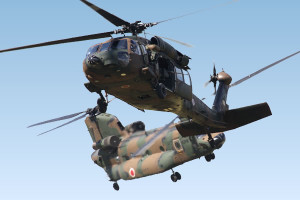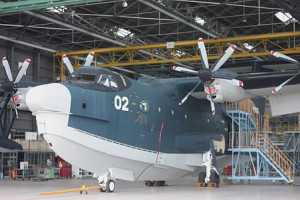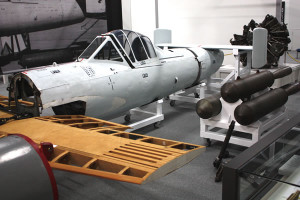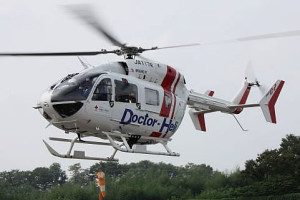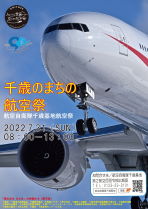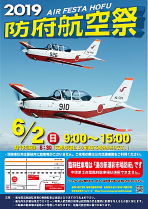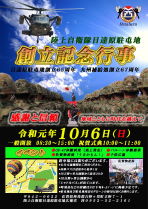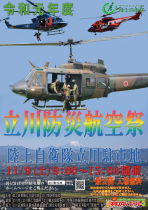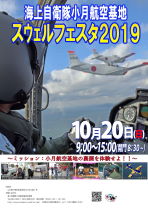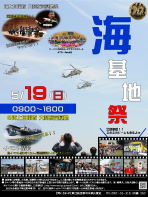JASDF Squadron Histories & Markings Part 3
This last part of the three-page coverage of JASDF squadron histories essentially covers those elements that are or were designated primarily by role, as follows:
| Unit Name | Notes |
| Aggressor Squadron | More common name for what is officially the Tactical Fighter Training Group (See dedicated page on this website) |
| Airborne Warning & Control Group (now Wing) | See Part 2, 601st Sqn and 602nd Sqn |
| Airborne Warning & Surveillance Group | See Part 2, 601st Sqn and 603rd Sqn |
| Air Defense Command HQ Squadron | 1958–2014 (See under Regional Air Defense HQ Support Flight Groups [Central]) |
| Air Development & Test Wing | Formerly Air Proving Group/Wing (See dedicated page on this website) |
| Air Rescue Training Squadron | Under Air Rescue Wing command |
| Air Rescue Wing | Formerly (1961–71) Air Rescue Group |
| Air Rescue Squadrons | See also Helicopter Airlift Squadrons |
| Air Tactics Development Wing | Formed Aug. 2014, oversees Tactical Fighter Training Group (Aggressor Sqn), Electronic Intelligence Squadron and Electronic Warfare Squadron |
| Air Training Group | See Part 2, 23rd Fighter Training Sqn |
| Air Transport Training Squadron | C-46, YS-11 (c.1970–78) |
| Air Transport Wing | 1958–1978 |
| Central Air Defense HQ Support Flight Group | 2014– (See under Regional Air Defense HQ Support Flight Groups) |
| ECM Training Flight | 1963–64 (See EW Squadron) |
| ECM Training Squadron | 1993–2014 (See EW Squadron) |
| Electronic Intelligence Squadron | YS-11EB |
| Electronic Warfare (EW) Squadron | (EC-1, YS-11EA) 2014– |
| EW Support Squadron | 1964–1993 (EC-46D, YS-11EA, EC-1) (See EW Squadron) |
| Flight Check Group | |
| Flying Training School | 1954–55 |
| Headquarters Squadron | Now Central Air Defense HQ Support Sqn (see under Regional Air Defense HQ Support Flight Groups) |
| Helicopter Airlift Squadrons | Also referred to as Helicopter Air Transport Squadrons |
| Iruma Squadron | See under Kisarazu Squadron. 402nd Sqn command unit 1968–1978 |
| Iwo To Drone Operation Flight | UF-104J/JA operations, 1992–97 |
| Kisarazu Detachment | 1958–59 |
| Kisarazu Squadron | 1959–1968 |
| Kisarazu Training Squadron | 1954–55 |
| Miho Detachment | 1955–58 |
| Northern Air Defense HQ Support Squadron | See under Regional Air Defense HQ Support Flight Groups |
| Provisional Air Training Flight | 1956–58 (See under Regional Air Defense HQ Support Flight Groups [Central]) |
| Provisional Matsushima Detachment | 1954–55 |
| Southwestern Air Defense HQ Support Squadron | See under Regional Air Defense HQ Support Flight Groups |
| Special Airlift Group | See Part 2, 701st Sqn |
| Tachikawa Air Transport Group | 1955 |
| Tactical Fighter Training Group | Aggressor Squadron (See dedicated page on this website) |
| Western Air Defense HQ Support Squadron | See under Regional Air Defense HQ Support Flight Groups |
 Thus far, Chitose AB’s 2nd Air Wing is unique in having its own assigned T-4,
Thus far, Chitose AB’s 2nd Air Wing is unique in having its own assigned T-4,
the marking for which was unveiled in December 2022 (see Bulletin Board).
(Photo [Hamamatsu, Dec. 2022]: 浜 松吉 via Twitter @anticoACL)
 (Image: JASDF Chitose AB via Twitter @jasdf_chitose)
(Image: JASDF Chitose AB via Twitter @jasdf_chitose)
|
Aggressor Squadron
|
Formed | Dec. 17, 1981 (Tsuiki, T-2 and T-33A) |
| Current Base | Komatsu (Air Tactics Development Wing, F-15J/DJ and T-4) | |
| See dedicated Tactical Fighter Training Group (Aggressor Squadron) page on this website |
||
 An F-15DJ of the Tactical Fighter Training Group gets airborne from its then base of Nyutabaru in
An F-15DJ of the Tactical Fighter Training Group gets airborne from its then base of Nyutabaru in
October 2014; the unit completed a move to Komatsu in June 2016. (Photo: Andy Binks)
|
Air Development & |
Formed | As Air Proving Group: Dec. 1, 1955 (T-34A at Hamamatsu) As Air Proving Wing: April 11, 1974 As Air Development & Test Wing: March 1989 |
| Current Base | Gifu (Air Development & Test Command, various aircraft) | |
| See dedicated AD&TW page on this website | ||
|
Air Rescue Wing |
Formed | As Provisional Air Rescue Sqn: Mar. 18, 1958 (Hamamatsu) As Air Rescue Squadron: Oct. 1, 1958 As Air Rescue Group: July 15, 1961 (Iruma) Air Rescue Wing: March 1, 1971 |
| Current Bases | (See chart in text below and Helicopter Airlift Squadrons) |
1958–1964
The nascent JASDF formed a provisional search and rescue (SAR) unit at Hamamatsu on March 18, 1958, which was granted full squadron status on October 1, 1958. In the meantime, its first mission had been undertaken by an H-19C on July 20. The squadron was divided into three elements: headquarters, training and maintenance.
The following year, 1959, saw the addition of SAR detachments at Chitose (formed February 1) and Komaki (May 15), and the commencement of rescue personnel parachute training with the JGSDF at Narashino, Chiba Prefecture, in late June.
The year 1960 saw the formation of another two detachments, at Nyutabaru in March and Matsushima in September, with the headquarters moving from Hamamatsu to Iruma in between times in July. The following year witnessed the formation of detachments at Komatsu (March 1, 1961) and Ashiya (July 15). The expansion of the JASDF dictated the air rescue organization’s elevation from squadron (Kōkū Kyūnantai) to group (Kōkū Kyūnangun) status on that same day, July 15, 1961.
Following the addition of Iruma (January 25, 1963), each of the then eight detachments was elevated to Air Rescue Squadron (ARS) status on December 1, 1964. New equipment, in the form of the S-62J, had arrived the previous year, the first arriving for deployment at Chitose on August 21, 1963.
 One of the two fixed-wing types initially used for rescue purposes, albeit only in small numbers,
One of the two fixed-wing types initially used for rescue purposes, albeit only in small numbers,
was the T-34A Mentor. Both the T-34As and the T-6Gs were fitted with underwing attachment
points for air rescue pods, which contained an inflatable rubber dinghy and survival kit.
The last T-34A was withdrawn from ARW use on October 20, 1982.
(Photo [undated]: JASDF Air Rescue Wing)
 Kōkū Fan Illustrated No. 108 states that 24 of the 180 T-6Gs supplied to the JASDF saw service
Kōkū Fan Illustrated No. 108 states that 24 of the 180 T-6Gs supplied to the JASDF saw service
with the ARW; the last was withdrawn from SAR use on March 26, 1969. The pictured example
is equipped with the underwing air rescue pods; also visible are the SAR and homing (SARAH)
system antennas. Having reached the end of its operational career when still officially on the
Niigata ARS’s books in March 1970, the aircraft was placed on display there for at least a
decade before disposal. (Photo [undated]: JASDF Air Rescue Wing)
 One of the 21 H-19Cs that entered service as the JASDF’s first rescue helicopter between 1957,
One of the 21 H-19Cs that entered service as the JASDF’s first rescue helicopter between 1957,
prior to the official formation of the rescue organization, and 1961; the first four were
purchased direct from Sikorsky, the remainder were licence-built by Mitsubishi. The
operational career of the last example was brought to an end on March 23, 1971.
(Photo [undated]: JASDF Air Rescue Wing)
 Displayed as part of a base history exhibit in a hangar at the Hamamatsu air show in September
Displayed as part of a base history exhibit in a hangar at the Hamamatsu air show in September
2014, this photo shows a mishap that befell a rescue H-19C in a field south of the base in the
early 1960s. Happily, having been delivered to the JASDF in July 1959, this aircraft was
repaired and remained in service until January 1973. After a period on display as part
a now defunct private collection in Gifu Prefecture, this aircraft was returned to
Hamamatsu and in April 1999 placed on display in the JASDF Air Park
collection, where it remained in pristine condition for many years.
That first actual mission, on July 20, 1958, involved the sending of an H-19C to rescue fishermen that had become stranded on a reef on the Atsumi Peninsula, Aichi Prefecture.
Just over a year later, on September 26, 1959, came the first major disaster response missions following the Ise Bay typhoon (Typhoon Vera), one of the most powerful ever to hit Japan. The city of Nagoya bore the brunt of a storm that killed more than 5,000, injured around 39,000 and left an estimated 1.5 million homeless in a severely damaged and extensively flooded city. The rescue effort involved the Air Rescue Training Squadron at Hamamatsu and the then only recently formed Air Rescue Detachment at Komaki. (Selected rescue episodes that have involved individual ARSs are included later, in the squadron histories.)
Organizationally, a system of nine search and rescue regions (SRRs) was put in place on December 24, 1960, to formalize chains of command, improve communications and thus shorten response times. Of those nine, only three were under overall JASDF command; even though having assigned JASDF elements operating in a separate JASDF chain of command, the others were all the responsibility of the JMSDF. At the time of the system’s inception, there were only five JASDF air rescue units. Essentially remaining unchanged until March 2017, when the JMSDF commands were abolished, at its peak the system was as appears below:
| Area of responsibility: Hokkaido Prefecture and surrounding area | |
| 1st SRR | Command: JASDF Northern Air Defense Force (Misawa) |
| ARS(s): Akita, Chitose, Matsushima | |
| Northern part of Sea of Japan; Pacific Ocean off Sanriku region (northeastern Honshu) |
|
| 2nd SRR | JMSDF 2nd Fleet Air Wing (Hachinohe) |
| Akita, Matsushima | |
| Eastern Honshu; Tokai, Hokuriku and Kinki regions; central part of Sea of Japan |
|
| 3rd SRR | JASDF Central Air Defense Force (Iruma) |
| Hamamatsu, Hyakuri, Komatsu, Niigata | |
| Boso Peninsula (Chiba Prefecture); Ogasawara Islands; Iwo To |
|
| 4th SRR | JMSDF 4th Fleet Air Wing (Atsugi) |
| Hamamatsu, Hyakuri | |
| Southern part of Sea of Japan; Chugoku region (western Honshu); sea around Shikoku |
|
| 5th SRR | JMSDF 31st Fleet Air Wing (Iwakuni) |
| Ashiya | |
| Kyushu (excluding southern area) | |
| 6th SRR | Western Air Defense Force (Kasuga) |
| Ashiya, Nyutabaru | |
| Southern Kyushu/seas around southern Kyushu | |
| 7th SRR | JMSDF 1st Fleet Air Wing (Kanoya) |
| Nyutabaru | |
| Ryukyu (Nansei) and Sakishima island chains | |
| 8th SRR | Southwestern Air Defense Force (Naha) |
| Naha | |
| East China Sea; waters around Okinawa | |
| 9th SRR | JMSDF 5th Fleet Air Wing (Naha) |
| Naha |
The Ashiya, Komatsu and Nyutabaru detachments were drafted in to assist in the relief efforts in the Hokuriku region (Ishikawa, Fukui and Toyama prefectures) during the excessively heavy snowfall of 1963. Bringing in supplies to cut-off communities and airlifting out people in need of medical treatment, the then Air Rescue Group elements were in action from January 27 to March 14.
The period June 16–28, 1964, marked the organization’s first major response to an earthquake and tsunami, which claimed the lives of 36 people and left nearly 400 injured. The Ashiya, Iruma, Komaki, Komatsu and Matsushima ARSs as well as the Hamamatsu-based Training Squadron assisted in the relief efforts that were centred on the city of Niigata.
 Niigata, June 1964. One of the many shocking sights encountered by JASDF helicopter crews during
Niigata, June 1964. One of the many shocking sights encountered by JASDF helicopter crews during
relief operations in the city, these apartment buildings had been built on reclaimed land by the
Shinano River and toppled by the effects of the liquefaction triggered by the earthquake.
(Photo via Wikimedia Commons)
 The seventh of the 10 H-21Bs donated by the U.S. Air Force, the first of which arrived in July 1960;
The seventh of the 10 H-21Bs donated by the U.S. Air Force, the first of which arrived in July 1960;
all entered service that year and were maintained by Shin Meiwa (now ShinMaywa) at the
company’s Itami facility at Osaka airport. Having lost two in accidents, the last of
the remaining eight was retired on Christmas Eve 1966.
(Photo [undated]: JASDF Air Rescue Wing)
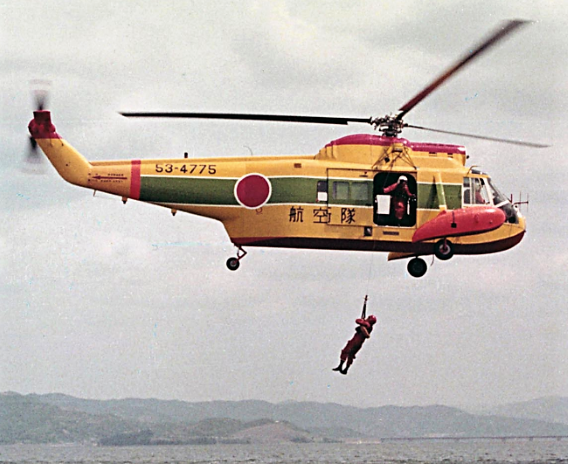 Flying the fifth of the nine colourful S-62Js operated by the JASDF, an ARS crew is put through its
Flying the fifth of the nine colourful S-62Js operated by the JASDF, an ARS crew is put through its
paces on a training flight. Although marking the start of a re-equipment process, the type was
not procured in large numbers due to the shortcomings of its single-engine performance;
the last example was retired on February 25, 1983, 20 years after the type’s service
entry. That pictured ended up on outdoor display close to the main gate at
Komaki AB, where it remains to this day.
(Photo [undated]: JASDF Air Rescue Wing)
1965–1971
The ninth ARS formed at Hyakuri on November 20, 1965. To improve response efforts in light of the lessons learned from the 1964 Niigata earthquake, the Niigata Base Squadron, which had come under the Air Rescue Group umbrella in December 1966, was made a full ARS in October the following year.
A long-term re-equipment programme was initiated in 1967, with ceremonies to mark the handover of the first KV-107II-5 and MU-2S being held on November 21 and December 2, respectively. The first pairings were deployed to Chitose and Komatsu on March 26, 1968, the year in which the Iruma ARS was disbanded (September 7).
Plans for a major reorganization culminated with the Air Rescue Group being given Air Rescue Wing (Kōkū Kyūnantai) status on March 1, 1971. On that day, what were now called the Flight Group (Hikōgun) and the Maintenance Group (Seibigun) came into being, the former’s HQ remaining at Iruma, the latter at Komaki, to where the now Training Group (Kyōikugun) had moved from Hamamatsu-South. The Komaki ARS disbanded on that day but was balanced by the Hamamatsu ARS newly forming as a replacement.
A major operation was initiated on July 4, 1971. The Chitose, Hyakuri and Matsushima units were all sent in search of a Toa Domestic Airlines YS-11 that had disappeared from the radar in bad weather when en route from Okadama to Hakodate the previous evening. Tragically, the aircraft had struck Mt. Yokotsu on the descent into Hakodate, and none of the 68 passengers and crew had survived.
1972–1992
To provide cover from Okinawa following its reversion turn to Japanese sovereignty, a provisional unit was formed at Naha in October 1972 and fully welcomed into the fold almost exactly a year later.
The decade ended with the first joint Japan-U.S. rescue training exercise, which was held in October 1979.
The 70s saw two major operations conducted in search of JASDF aircraft that had crashed into the sea. On May 1, 1973, elements from all four ARSs comprising the 3rd SRR—Hamamatsu, Komatsu, Niigata and Hyakuri—converged on the latter to coordinate efforts to locate and rescue the crew of a Provisional F-4EJ Squadron (the forerunner of the 301st Sqn) that had crashed into the Pacific following an in-flight explosion on a training flight; the pilot was the squadron’s commanding officer. The location was only around 30 nautical miles (55km) off Nakaminato, Ibaraki Prefecture, but both crew members were presumed to have been killed when the search was called off on May 5.
A sea search for another missing JASDF aircraft, this time an F-86F Sabre from the 3rd Sqn during its time under the 81st Air Group at Misawa, was initiated on April 11, 1977. After an initial response by the Chitose ARS, aircraft and personnel from Hyakuri, Matsushima, Komatsu and Niigata as well as Chitose were amassed at Misawa. Sadly, in this case after six days of searching the crash area, around 40 nautical miles (75km) northwest of the Oga Peninsula, Akita Prefecture, no trace of the pilot was found.
Combined ARS Rescue Operations 1981–1991
| Date | Notes |
| Jan. 7, 1981 | Airlifting supplies and airlifting those stranded following heavy snowfall in Hokuriku region |
| Units: Komatsu ARS, Training Sqn | |
|
Aug. 12–Oct. 12, 1985 |
JAL Flight 123 tragedy, Mt. Osutaka, Gunma Prefecture |
| (Although ARW mobilized, no helicopter rescues could be conducted) |
|
| Aug. 5–6, 1986 | Record rainfall from a tropical depression (downgraded from that year’s Typhoon No. 10) in the Kanto and Tohoku regions. Flooding in Ibaraki Prefecture after rivers burst their banks |
| Hyakuri, Matsushima | |
|
Mar. 13–15, 1987 |
F-15J crashes into Pacific 120 miles (190km) NNE of Hyakuri. Nothing found after prolonged search |
| Komatsu, Niigata, Training Sqn | |
| June 29–July 2, 1988 |
Two Komatsu-based F-15Js crash into Sea of Japan during training flight. Despite major operation, no trace found |
| Komatsu; Hamamatsu, Hyakuri, Matsushima, Niigata, Training Sqn |
|
| Jan. 9–11, 1991 |
Three groups (total of 12 climbers) get into difficulties in severe winter conditions in Northern Alps; 10 rescued by ARS, two by Toyama Prefectural Police helicopter |
| Komatsu, Training Sqn |
The formation in 1992 of the last Chinook-equipped Helicopter Airlift Squadron (see later) at Kasuga added the final piece to the organization that has remained essentially unchanged to this day.
 (Photo [Hofu, July 1994]: Takao Kadokami)
(Photo [Hofu, July 1994]: Takao Kadokami)
To mark its Golden Jubilee in 2008, the Air Rescue Wing stole the idea adopted for the same event on a service-wide scale four years before. The same commemorative marking, predominantly featuring a blue eagle on the fuselage sides, was applied to one example of each of the types then in service. Teams at Niigata and Chitose prepared a KV-107IIA-5 and a UH-60J, respectively, and Hamamatsu an MU-2A; for some reason, although Hamamatsu provided a U-125A, so did Akita ARS. The likewise specially marked CH-47J was based at Misawa. (A section on markings follows the ARS histories.)
The system of nine search and rescue regions (SRRs), which had been in place since 1960, was streamlined to just four entirely under JASDF command in March 2017.
| Area of responsibility: Hokkaido Prefecture and surrounding area; northern part of Sea of Japan |
|
| 1st SRR | Command: Northern Air Defense Force (Misawa) |
| ARS(s): Akita, Chitose | |
| Pacific Ocean off Sanriku region (northeastern Honshu) and Boso Peninsula (Chiba Prefecture); Ogasawara Islands/Iwo To; northern Honshu; Tokai, Hokuriku and Kinki regions; central Sea of Japan |
|
| 2nd SRR | Central Air Defense Force (Iruma) |
| Hamamatsu, Hyakuri, Komatsu, Matsushima, Niigata | |
| Southern Sea of Japan; Chugoku region (western Honshu); sea around Shikoku; Kyushu; southern Kyushu and surrounding waters |
|
| 3rd SRR | Western Air Defense Force (Kasuga) |
| Ashiya, Nyutabaru | |
| Ryukyu (Nansei) and Sakishima island chains; East China Sea; waters around Okinawa |
|
| 4th SRR | Southwestern Air Defense Force (Naha) |
| Naha |
On June 2, 2018, around 200 top-ranking officers and officials as well as unit members past and present attended a ceremony to mark the 60th anniversary of the ARW at its Iruma headquarters. Representatives from all 11 far-flung outposts were present, as were 16 previous commanding officers and seven members who had received commendations.
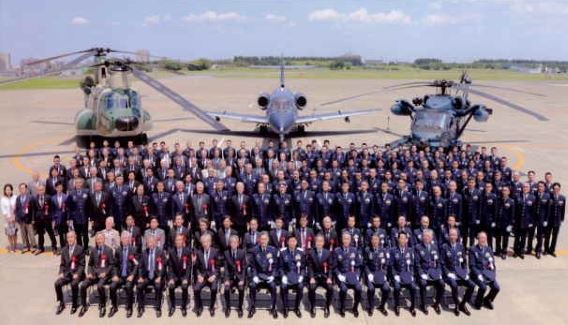 (Photo [Iruma, June 2, 2018]: Air Rescue Wing, JASDF)
(Photo [Iruma, June 2, 2018]: Air Rescue Wing, JASDF)
A service was held in the unit’s hangar, during which a minute’s silence was observed to remember the 55 ARW crew members who have lost their lives on active duty.
According to official operational data, over the years of its existence the ARW had (as at May 31, 2018) carried out 248 air rescue missions, during which 149 people have been rescued, and been launched to assist in disaster-stricken areas 2,492 times, rescuing 6,693 people, airlifting 1,188 patients and 14,279 personnel in the process.
Air Rescue Wing Operational Data*
| SAR | 2016 | 2017 | 2018 | 2019* | Cumulative* |
| Missions | 1 | 3 | 1 | 1 | 250 |
| No. rescued | 6 | 1 | 2 | 0 | 151 |
| Disaster Relief | |||||
| Missions | 24 | 24 | 30 | 5 | 2,525 |
| Rescuees/patients | 14 | 169 | 45 | 4 | 6,723** |
| Personnel | 195 | 42 | 658 | 4 | 14,938*** |
| Freight (kg) | 56,090 | 302,547 | 33,863 | 55,000 | 4,636,857 |
| Airlift | |||||
| No. of flights | 680 | 597 | 514 | 69 | 23,870 |
| Personnel | 14,150 | 12,768 | 12,332 | 1,680 | 452,370 |
| Freight (kg) | 318,971 | 353,626 | 237,599 | 28,727 | 10,107,809 |
(*) Cumulative total as at May 31, 2019 (data from ARW website)
(**) Of which 3,443 rescuees/casualties following 2011 Great East Japan Earthquake and tsunami.
Cumulative total of patients specially airlifted to hospital: 1,206
(***) Of which 3,947 following 2011 Great East Japan Earthquake and tsunami.
The ARW has not been averse to allowing the visual media access to raise its profile and assist in recruitment. The Hyakuri ARS appeared in the January 2014 TV drama version of the manga S–Saigo no Keikan (S–Last Police Officer), but of more direct relation was its appearance as a location for the feature film Sora He (Rescue Wings) in 2008—see the Komatsu ARS squadron history entry—and for the 2013 TV drama Sora Tobu Kōhōshitsu (Public Affairs Office in the Sky).
Also on TV, personnel at Ashiya, Chitose and Matsushima assisted in the shooting of one of the long-running Sekai Ichi Uketai Jugyō (The Most Useful School in World) series of educational variety shows that aired on Nippon TV in January 2016.
The ARW motto, 他を生かすために (hoka wo itasu tame ni), is the second half of that of the U.S. Air Force Special Operations Command pararescuemen—“These Things We Do, That Others May Live”—and also happens to be the title of a long-running series in Kōkū Fan magazine that astoundingly reached Part 100 in the December 2020 issue.
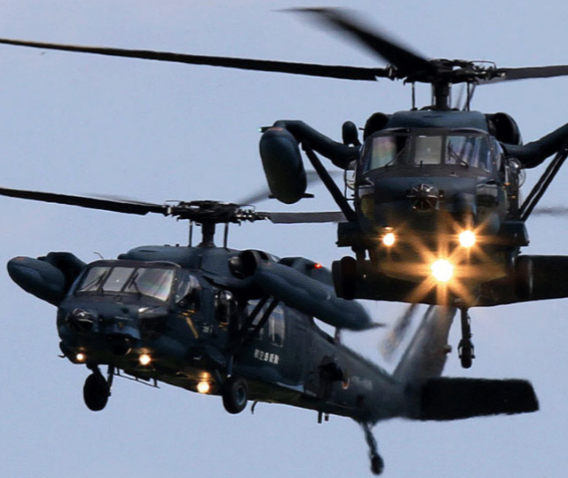 (Photo: JASDF Chitose AB)
(Photo: JASDF Chitose AB)
************************************
As listed in chronological order below, 12 detachments were formed between February 1959 and March 1987. In Japanese, these were initially designated Kyūnan Bunkentai from February 1, 1959 to November 30, 1964, and Kyūnantai from December 1, 1964, at which time eight were already in existence.
Formed at Hamamatsu on October 1, 1958, an Air Rescue Training Squadron (Kyūnan Kyoikutai) moved to Komaki on March 1, 1971, negating the need for that base to retain its dedicated unit, which disbanded that same day.
 In what would have been a welcome sight to many people in distress at sea, an Ashiya-based
In what would have been a welcome sight to many people in distress at sea, an Ashiya-based
MU-2S makes a low pass as a precursor to the arrival of a KV-107II rescue helicopter.
(Photo [Tsuiki, Nov. 1985]: Takao Kadokami)
| Formation of Air Rescue Squadrons (in chronological order) |
||
| Base | As Rescue Detachment | As Air Rescue Sqn |
| Hamamatsu | Mar. 18, 1958* | (1) Oct. 1, 1958 (2) Mar. 1, 1971 |
| Chitose | Feb. 1, 1959 | Dec. 1, 1964 |
| Komaki | May 15, 1959 | Dec. 1, 1964** |
| Nyutabaru | Mar. 1, 1960 | Dec. 1, 1964 |
| Matsushima | Sept. 20, 1960 | Dec. 1, 1964 |
| Komatsu | Mar. 1, 1961 | Dec. 1, 1964 |
| Ashiya | July 15, 1961 | Dec. 1, 1964 |
| Iruma | Jan. 25, 1963 | Dec. 1, 1964*** |
| Hyakuri | – | Nov. 20, 1965+ |
| Niigata | (Base Sqn Dec. 15, 1966) | Oct. 25, 1967 |
| Naha | Oct. 30, 1972++ | Oct. 16, 1973 |
| Akita | Jan. 29, 1987+++ | Mar. 31, 1987 |
* As Provisional Air Rescue Squadron
** Disbanded Mar. 1, 1971, due to relocation of training unit
*** Disbanded Oct. 1, 1968
+ Some sources give Feb. 1, 1965
+++ As Provisional Naha Detachment
+++ As Provisional Akita Detachment
 An ARW KV-107IIA-5 and UH-60J on a murky day at Gifu in October 2000. A protracted process,
An ARW KV-107IIA-5 and UH-60J on a murky day at Gifu in October 2000. A protracted process,
the changing of the guard, by which KV-107II/MU-2A* pairings were replaced by UH-60J and
U-125As acting in concert, was initiated in the early 1990s but not completed until 2009.
| Aircraft Operated by JASDF Air Rescue Units | |||||
| H-19C | 1958–1971 | H-21B | 1960–1966 | MU-2S/A* | 1967–2008 |
| T-6G | 1958–1970 | S-62J | 1963–1983 | UH-60J | 1991– |
| T-34A | 1958–1982 | KV-107II | 1967–2009 | U-125A | 1995– |
* Although generally referred to as the MU-2S, the JASDF operated the type in two versions. Powered by 605 hp TPE-331 engines, the MU-2S was the initial version, while the later (from the 18th aircraft) MU-2A had uprated 665 hp engines. This photo (link) reveals that the wingtip tanks on the Niigata ARS MU-2A nearest the camera are longer than those of the Matsushima ARS MU-2S parked immediately behind.
AIR RESCUE SQUADRONS IN ALPHABETICAL ORDER BY BASE
AKITA
(Formed as Provisional Akita Detachment Jan. 29, 1987,
redesignated Akita ARS Mar. 31, 1987)
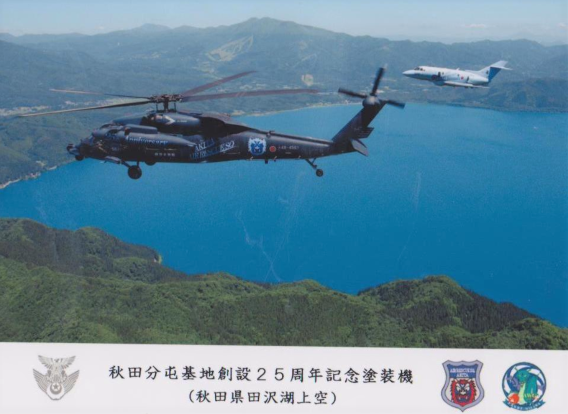 In 2012, the unit’s 25th anniversary year, the two Akita ARS aircraft overfly Lake Tazawa, the
In 2012, the unit’s 25th anniversary year, the two Akita ARS aircraft overfly Lake Tazawa, the
deepest in Japan, which is used for training exercises. (JASDF Akita Sub-Base)
After a two-month existence as the Provisional Akita Detachment, which was established on January 29, 1987, by far the youngest JASDF ARW unit was officially given full squadron status on March 31, 1987. Formed to enhance the search and rescue (SAR) cover on that stretch of the Sea of Japan coast and throughout northern Honshu, the unit’s initial equipment—the then standard pairing of an MU-2S and a KV-107II-5—had arrived three weeks before, on March 11.
 The stalwart MU-2 remained in service with the Akita ARS for 15 years. The first MU-2S arrived in
The stalwart MU-2 remained in service with the Akita ARS for 15 years. The first MU-2S arrived in
March 1987, and the unit bade farewell to the last example of an MU-2A (below) in February 2002.
(Photos: JASDF Akita Sub-Base)

In that first year of operations, missions ranged from reconnaissance flights over forest fires in April and searching for missing persons at a beach swimming area in July and August to rescuing the crew of a trawler that had run aground in November 1987.
The unit’s operations have naturally covered the full gamut of missions normally associated with an SAR unit. Aside from going to the assistance of those in peril on or near the sea, the unit is called upon for more offbeat duties. In January 1989 for example, flights were dispatched to provide situation reports of the mudflow in the vicinity of the crater following signs of volcanic activity on Mt. Chokai in southern Akita Prefecture.
A major operation in the early years resulted in the rescue of a 12-person ski party that had found itself in difficulties on Mt. Nyuto in March 1995.
 Equipped with the KV-107II-5 and then ‘IIA-5 since its formation, the Akita ARS relinquished its
Equipped with the KV-107II-5 and then ‘IIA-5 since its formation, the Akita ARS relinquished its
last example 20 years later, in 2007. (Photo: JASDF Akita Sub-Base)
In July 1997, the local ARS took part in the Akita Defense Festival. Due to bad weather at Hamamatsu, the planned display by the Blue Impulse had to be cancelled, and so the Akita ARS gave a demonstration of a KV-107II performing a sea rescue instead (link). The landmark Akita Port Tower Selion had been open since April 1994 (link).
In November 2000, Akita ARS took part in the rescue a Misawa-based U.S. Air Force pilot following a collision involving two F-16s during Exercise Keen Sword. In April 2002, the unit was also called upon to assist in the successful rescue of another F-16 pilot, who had ejected after experiencing an engine failure.
In between those incidents, the U-125A was introduced on March 27, 2001, and the MU-2A made its last flight on February 21 the following year. The first UH-60J was supplied on March 22, 2004, and the rotorcraft complement temporarily increased to three with the arrival of another UH-60J on November 1, 2005. The KV-107IIA-5 soldiered on until its last flight, which took place on September 10, 2007; see the Akita entry under JASDF Base Histories.
In late October 2004, the Akita ARS was one of the units that participated in the disaster relief operations that followed a series of earthquakes in the Chuetsu region of Niigata Prefecture. Claiming the lives of 68 people, injuring thousands and forcing 100,000 from their homes, this had been the largest seismic event to strike Japan since the Great Hanshin Earthquake of 1995.
 (Photo: Japan Ministry of Defense)
(Photo: Japan Ministry of Defense)
An interview with a crew member, Technical Sgt. Yamazaki (above), appeared in the white paper Defense of Japan 2005. When asked about any difficulties he encountered on what was his first disaster relief operation, he replied that his natural sense of unease at his “baptism of fire” was compounded by the lack of detailed information about the affected areas. As many of those in need of rescue were anxious elderly people, the rescue mission took a lot more time than he had expected.
The first steps to extend the radius of helicopter rescue operations by in-flight refueling were taken in the spring of 2009, when there were already plans for the JASDF to add a KC-130H Hercules/UH-60J capability. Major Eiji Sekine of the Akita ARS was one of the first four JASDF helicopter pilots to undergo training with the U.S. Air Force’s 33rd Rescue Squadron at Kadena AB, Okinawa Prefecture. After a day’s ground school, each pilot received two hours of hands-on procedural flight training in daylight on an HH-60G Pave Hawk with the USAF and U.S. Marine Corps providing the Hercules tankers.
It was in 2008 that the Akita ARS started to make the change from the UH-60J’s original yellow and white colour scheme to the blue camouflage scheme, and both schemes were on show at the regional training meet for the Hokkaido and Tohoku block in October of that year. The Akita ARS had been involved in another disaster relief operation only four months before, when crews had airlifted to hospital some of those injured by the Iwate-Miyagi Nairiku Earthquake.
The Japanese-language website of Akagi Kougyou Co., Ltd. (http://www.akagi-aaa.co.jp), a Tokyo-headquartered supplier of specialized clothing and other products to the Self-Defense Forces, includes a series of reports on visits made in recent years to air rescue squadrons. That to the Misawa sub-base of Akita, which was then under the command of Col. Takeshi Nakazawa, was made in July 2014.
Although air rescue squadrons normally have a staff of around 80, those at Akita and Niigata have 200 personnel, because their role as self-contained sub-bases necessitates having their own related sections, such as supply, security, accounting and facility management. Whereas ARSs at major bases are able to focus on their rescue role, these two sub-bases are also tasked with performing their own base operations, such as the airlift of personnel and materiel.
The three conjoined prefectures on that stretch of the Sea of Japan coast—Yamagata, Niigata and Akita—rank one to three, respectively, in terms of annual snowfall; in Akita, it is not unusual for it to snow heavily as late as May. The Akagi reporter was informed that conditions can pose problems and take a while to get used to for those unit members born and raised outside Japan’s snow regions.
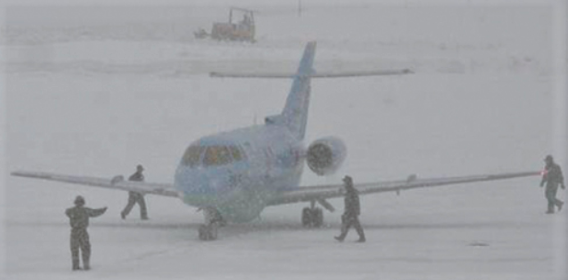 Despite the conditions, an Akita ARS U-125A is made ready for departure on a training flight.
Despite the conditions, an Akita ARS U-125A is made ready for departure on a training flight.
Keeping the runway clear of snow involves the efficient utilization of base personnel and
equipment, and the goal is to finish snow clearing within an hour. (Photo: JASDF Akita Sub-Base)
As if snow were not enough to contend with, the region has a high incidence of thunder and lightning in autumn and winter. Although a self-contained base, one facility not at their direct disposal is weather radar; meteorological information is provided from the parent base at Misawa and from the adjoining Akita airport.
A page on the Akita Sub-Base website (link) includes no less than 18 interviews with personnel engaged in a wide variety of base occupations. Dating back to November 2013, on the U-125A flight operations side they feature a ground crewman and a radio operator (RO), on the UH-60J side a flight engineer (FE) and rescuer.
According to the unit’s website, as at January 12, 2016, the Akita ARS had been deployed on disaster prevention missions on 106 occasions, and its running total of the number of people rescued stood at 415. A chronological overview of some of the missions conducted in recent years is set out below.
January 5, 2010. The Akita ARS conducts the emergency airlift of a crew member in need of medical treatment from a tanker anchored off the port of Funakawa.

March 2011 (above). The unit is naturally part of the mass mobilization of first responders and disaster relief units in the aftermath of the Great East Japan Earthquake of March 11, 2011. (Photo [Mar. 13, 2011]: JASDF Akita Sub-Base)

October 7, 2011. Rescues avalanche victims on Mt. Iwate in neighbouring Iwate Prefecture. (Photo: JASDF Akita Sub-Base)

March 2, 2012. A child suffering from pneumonia following a liver transplant is emergency airlifted from Akita airport to a specialist hospital in Tokyo. (Photo: JASDF Akita Sub-Base)
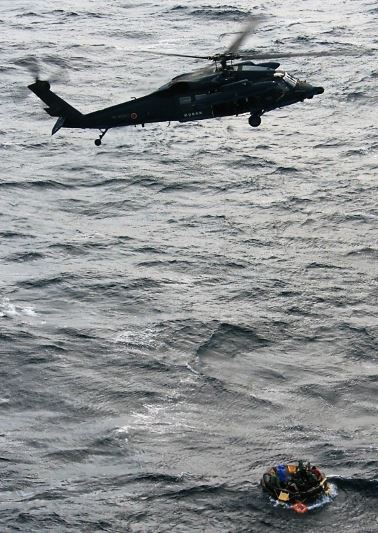
February 21, 2013. At the request of the Japan Coast Guard (JCG), which had received a distress signal, the Akita ARS scrambles both its UH-60Js. In an operation coordinated with the Niigata ARS, the unit rescues the 12 crew members (three South Korean and nine Chinese nationals) of a Cambodian-registered freighter who were drifting in a life raft 300 kilometres off Sado Island, Niigata Prefecture. (Photo: Japan Ministry of Defense)
March 15–18, 2013. An aerial search is made for a powered glider that had taken off from Memanbetsu airport, Hokkaido Prefecture, and failed to arrive at its destination, Shikabe airfield. On the morning of the third day of the search, the crew of an Akita ARS UH-60J spots the wreckage of the glider on Mt. Satsunai in the Hidaka mountain range and rescues its two former occupants.
January 31, 2014. An urgent medical case arises on board the Panamanian-registered chemical/oil tanker Southern Dragon while at anchor off the port of Funakawa. Bad weather forces back a JCG helicopter launched from Sendai and, as a result, the Akita ARS receives a request from the JCG to immediately scramble a UH-60J. The medical case, a Filipino crewman, is winched aboard and airlifted to Akita airport.

December 23, 2014. A Panamanian-registered vessel ends up beached eight kilometres south of the port of Sakata, Yamagata Prefecture. The initial rescue mission involves JCG aircraft from Niigata and Sendai air stations, but this plan has to be abandoned due to the snow clearing status at both bases and poor weather en route. Consequently, Akita ARS dispatches a U-125A and UH-60J and airlifts 10 of the vessel’s 18-man crew, all of whom are from Myanmar, to safety at Shonai airport, Yamagata Prefecture. The other eight are rescued by the Yamagata Prefectural Disaster Prevention Aviation Unit. (Photo: JASDF Akita Sub-Base)
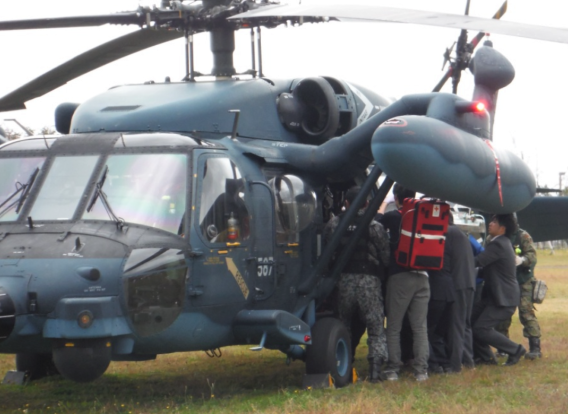
October 20, 2015. Due to the deteriorating condition of an already hospitalized infant suffering from a congenital disease, the Akita Prefecture governor grants permission for an emergency airlift. An Akita ARS UH-60J is dispatched to convey the patient direct to a specialist medical facility in Tokyo. (Photo: Japan Ministry of Defense)

January 10, 2016. The Panama-registered cargo ship City runs aground on a breakwater close to Miyaumi beach in the city of Sakata, Yamagata Prefecture, and the numbers involved in the ensuing rescue operation require that the Akita ARS U-125A and a UH-60J work in concert with a JCG helicopter. All 18 of the ship’s Russian and Bangladeshi crew are hoisted to safety without injury, 10 of them being picked up by the Akita ARS UH-60J. (Photo: Japan Ministry of Defense)
 The pilots of an Akita ARS UH-60J receive the thumbs up from a ground crew member at the start
The pilots of an Akita ARS UH-60J receive the thumbs up from a ground crew member at the start
of exercise Cope Angel 17 at a rainswept Misawa AB on August 9, 2017. Their brief for this
simulated mission involved the recovery and return to Misawa of a downed pilot.
(Photo: U.S. Air Force/Staff Sgt. Melanie A. Hutto, 35th FW Public Affairs)
October 18, 2017. Tragically, a Hamamatsu ARS UH-60J crashes into the sea around 30 kilometres south of its base when on a night training exercise on the evening of October 17. The Akita ARS is among the JASDF and JCG elements that continue an ultimately fruitless search for survivors from the four-man crew through to the afternoon of the following day.
April 9, 2019. As the accident occurred within its operational area, the Akita ARS was naturally one of several units involved in the search for the pilot of an F-35A that crashed while on a night training flight from Misawa. The first pieces of wreckage were recovered by an Akita UH-60J crew just over two hours after the accident.
August 1, 2019. A passenger was suddenly taken ill on board the UK-registered luxury liner Diamond Princess, which was en route from Vladivostok to Aomori Port. Due to operational radius problems with aircraft from other organizations, it fell to an Akita ARS U-125A and UH-60J to respond to a request for assistance from the 9th Regional Coast Guard Headquarters. Airlifted directly from the ship to Aomori Airport, the patient was then transferred into the care of a waiting local ambulance crew.
August 11, 2019. Due to the worsening condition of an infant hospitalized in Aomori Prefecture, the Aomori Prefecture governor decided an emergency patient airlift was urgently needed. In response to the request, an Akita ARS U-125A crew flew the patient from Aomori Airport to JASDF Iruma AB, Saitama Prefecture, for transfer to a local ambulance crew.
 (Japan Ministry of Defense/JASDF)
(Japan Ministry of Defense/JASDF)
For its marking, the squadron adopted the bogeyman-like namahage of local folklore. On New Year’s Eve, fake knife-wielding masked men dressed as namahage are invited to make house-to-house visits in a (for some) terrifying search for lazy or badly behaved children. This to Western eyes hardly positive image for a search and rescue unit gained credence in 2018 when UNESCO added the namahage in the city of Oga, Akita Prefecture, to its tourism-boosting intangible cultural heritage list. (Namahage have been on the Japanese list of now more than 300 Important Intangible Folk Cultural Properties since 1978.)
More befitting of the Akita ARS is the namahage’s association, since time immemorial, with the bestowing of blessings to ward off calamities in all their forms. In having chosen this deep-rooted local symbol, the thinking was that the unit, long before the UNESCO listing, could assist in handing down this aspect of local culture from generation to generation. As described on the unit’s website, the two colours on and around the face, red and blue, symbolize mutual cooperation among the unit’s various elements in safely carrying out its mission.
AKITA ARS SPECIAL MARKINGS
May-September 2008, Air Rescue Wing 50th Anniversary U-125A 12-3017 (link) (link)
To mark its Golden Jubilee, the Air Rescue Wing stole the idea adopted for the same event on a service-wide scale four years before. The same commemorative marking, predominantly featuring a blue eagle on the fuselage sides, was applied to one example of each of the types then in service. For some reason, although Hamamatsu provided a U-125A, so did Akita ARS.
 (Above and below) Not surprisingly, the Akita ARS’s namahage marking featured prominently in the
(Above and below) Not surprisingly, the Akita ARS’s namahage marking featured prominently in the
design selected for the unit’s 25th anniversary in 2012 (link). (Photos: JASDF Akita Sub-Base)
October 2017 30th Anniversary/Aviation Day U-125A 12-3017 /
UH-60J II 68-4600 (link); both aircraft (link)
Held the day after the official base 30th anniversary ceremony, the Aviation Day event enabled members of the public to get a close look at the markings, which had resulted from an intrasquadron call for design ideas. The winning design primarily comprised a hatahata, a species of sandfish for which Akita is famous, with blue waves. Also on the U-125A’s fuselage were a yellow flash and the words Air Rescue AKITA in blue, while the inscription 30th Anniversary in red outlined in white and a namahage mask (see previous link) had been added to the tail; its engines also sported two blue waves (link).
The UH-60J II had had the inscription and mask applied to its tanks, and the fuselage markings were grouped together on the rear of the cabin fuselage (link). To make them stand out against the dark blue camouflage scheme, the fish and waves had been changed to white.
 The ARW motto featured prominently on the poster used to publicize the 2018 open house event.
The ARW motto featured prominently on the poster used to publicize the 2018 open house event.
Poor weather on the day limited the flying display to a UH-60J rescue demonstration,
which can be viewed on YouTube (link). (JASDF Akita Sub-Base)
September 2022 35th Anniversary U-125A 92-3026 / UH-60J 18-4612
 Each aircraft carried this simple anniversary marking on both sides of its fuselage
Each aircraft carried this simple anniversary marking on both sides of its fuselage
(right sides shown).
 (Photos: 野比野比子 via Twitter @mie0810)
(Photos: 野比野比子 via Twitter @mie0810)
 The Akita ARS 35th anniversary UH-60J on a visit to Komatsu
The Akita ARS 35th anniversary UH-60J on a visit to Komatsu
(Photo [Sept. 27, 2022]: moni via Twitter @monimoni1002)
ASHIYA
(Formed as Ashiya Rescue Detachment July 15, 1961,
redesignated Ashiya ARS on Dec. 1 1964)
 (Photo [Ashiya, Oct. 1978]: Takao Kadokami)
(Photo [Ashiya, Oct. 1978]: Takao Kadokami)
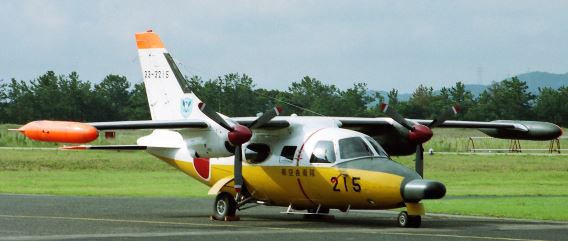 (Above and below) The MU-2S and KV-107A-5 resident with Ashiya ARS in late September 2000
(Above and below) The MU-2S and KV-107A-5 resident with Ashiya ARS in late September 2000

Following the U.S. government’s complete return of Ashiya to Japanese control at the end of 1960, a JASDF air rescue detachment (the sixth) was formed at the base on February 1, 1961, the same day that the Air Rescue Squadron in overall command was re-designated the Air Rescue Group. Full ARS status came to the Ashiya unit on December 1, 1964. Its 120 personnel were initially provided with four T-34As, two H-21Bs and an H-19B.
 The nascent JASDF’s initial fixed-wing SAR aircraft was the T-34A Mentor. This example was
The nascent JASDF’s initial fixed-wing SAR aircraft was the T-34A Mentor. This example was
photographed at Ashiya in March 1973. (Photo: Akira Watanabe)
During its early years, Ashiya H-21Bs were unfortunately involved in two major accidents that resulted in multiple fatalities, the first suffered by the air rescue units. The first, which claimed 10 lives, occurred in thick fog in the mountains near the town of Takuma, in the Mitoyo district of Kagawa Prefecture, on March 16, 1963. On September 10 the following year, eight of the 11 occupants were killed when the helicopter came down in a rice field in the Kasuya district of Fukuoka Prefecture.
Ashiya ARS Early Rescue Episodes
| Date | Notes |
| May 14, 1967 | Goes to assistance of trawler in difficulties off Onga river estuary, Fukuoka Prefecture, four crewmen rescued |
| Feb. 14, 1969 | Trawler capsize, five rescued |
| July 11, 1970 | Rescues two fishermen from Hakata Bay, Fukuoka Prefecture |
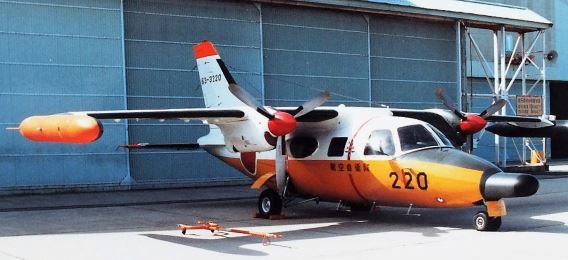 (Photo [Tsuiki, Nov. 1987]: Takao Kadokami)
(Photo [Tsuiki, Nov. 1987]: Takao Kadokami)
Changes were made to its assigned fixed-wing aircraft in 1968 (arrival of the first MU-2S) and 1971 (T-34A retirement). By the time the last MU-2A was retired in 2002, the unit had previously operated three types of helicopter—the H-21B (1961–68), the H-19B (1961–71) and the S-62J (1968–71)—and the fourth, the KV-107IIA-5, was to bow out the following year. The current equipment, the UH-60J and U-125A, commenced operations in June 2001 and May 2002, respectively.
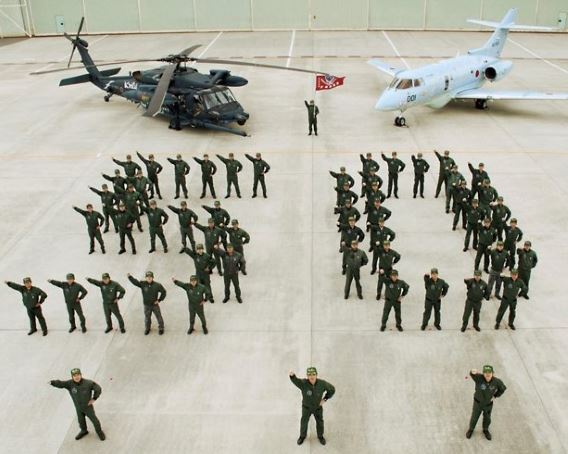 At the time of its 50th anniversary in March 2012, the unit had 84 personnel and was equipped
At the time of its 50th anniversary in March 2012, the unit had 84 personnel and was equipped
with two U-125As and three UH-60Js. (Photo: JASDF Ashiya AB)
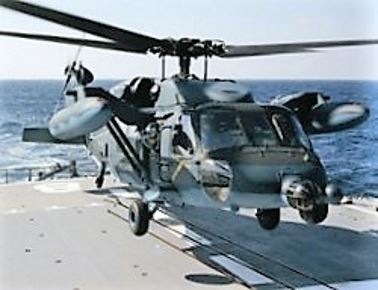 As part of ongoing readiness training, an Ashiya-based UH-60J hovers above the
As part of ongoing readiness training, an Ashiya-based UH-60J hovers above the
helicopter deck of the JMSDF Murasame-class destroyer Akebono during a
joint exercise in July 2012. (Photo: JASDF Ashiya AB)
When the Akagi Kougyo company visited in July 2013, the emergency airlift from the remote island of Mishima was happening roughly once every two months, the Ashiya ARS having assumed the mantle previously worn by the JMSDF’s Ozuki Rescue Flight prior to its move to Omura in Nagasaki Prefecture.
As at December 15, 2017, the Ashiya ARS had been dispatched on 267 disaster-relief missions; as at July 15, 2011, the figure stood at 238, plus 52 air rescues. Typical examples of the missions that the unit has undertaken in recent years include the following:
June 2010. Airlift of five people from the tiny island of Yakatajima, off the city of Saiki, Oita Prefecture.
January 2011. The search for a Cessna that had departed Kumamoto airport on the evening of January 4 ends with the discovery of wreckage in the mountains near Ozu. The accident claimed the lives of the doctor private pilot and his wife.
March 2011 Great East Japan Earthquake. The Ashiya ARS is drafted in to assist with SAR, airlift and reconnaissance operations during disaster relief operations.
In the course of 2013 is called upon to airlift seven hospital cases in Yamaguchi Prefecture; seven from the island of Mishima to Hagi, and one from Mishima to Hofu. (Had airlifted 18 and four cases, respectively, in the period 2008 to 2012.)
September 1, 2015. Joins in search for the crew of a fishing boat, one of six that have capsized on the same day, off Tsunoshima, Yamaguchi Prefecture. The ship’s captain is rescued, but no trace of the rest of the crew is found.
April 2016. In the aftermath of a series of earthquakes that struck Kumamoto, the Ashiya ARS undertakes reconnaissance missions and the airlift of water and other essential supplies.
December 7, 2016. Assists in the search for a U.S. Marine Corps pilot who is found to have lost his life when he ejected from his F/A-18 Hornet off Tosashimizu, Kochi Prefecture, during a night exercise.
July 2017 Heavy Rainfall in Northern Kyushu
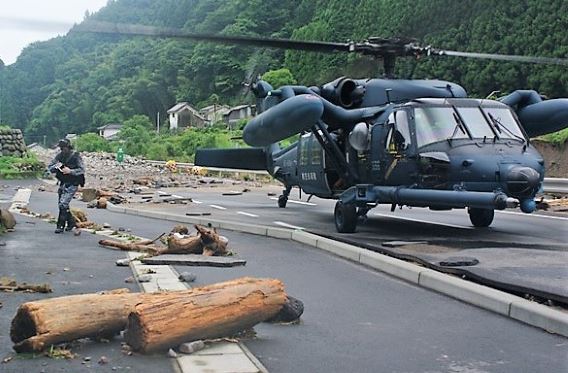 An Ashiya crew lands in the Ono district of Hita, Oita Prefecture, to assess the situation after the
An Ashiya crew lands in the Ono district of Hita, Oita Prefecture, to assess the situation after the
area was cut off by severe flooding and landslides caused by torrential rainfall. The unit comes
to the assistance of a total of 78 people during the course of this operation.
(Photo: JASDF Ashiya AB)
 During the same rescue operation, another Ashiya crew sets down to await orders in the
During the same rescue operation, another Ashiya crew sets down to await orders in the
Ibome district of Asakura, Fukuoka Prefecture. (Photo: JASDF Ashiya AB)
October 22, 2017. In response to a request made by the Yamaguchi prefectural governor to the commander of the Ashiya-based 3rd Technical School, a UH-60J is dispatched to airlift a patient from the JASDF Mishima Sub-Base to the Kozoe River Park and hospitalization in Hagi.
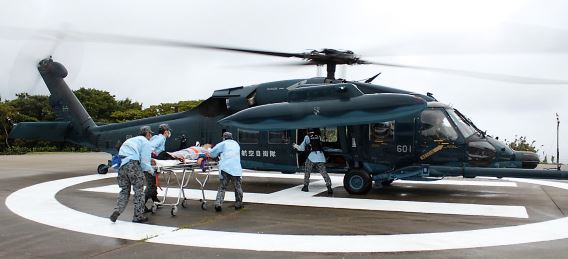 (Photo [JASDF Mishima Sub-Base, Oct. 22, 2017]: JASDF Ashiya AB)
(Photo [JASDF Mishima Sub-Base, Oct. 22, 2017]: JASDF Ashiya AB)
April 9, 2018. An Ashiya-based UH-60J is used to gather damage information on the areas affected by an earthquake that strikes Shimane Prefecture.
December 6–11, 2018. Ashiya U-125A and UH-60J crews work in conjunction with their ARS counterparts at Hamamatsu and Nyutabaru as well as with the Japan Coast Guard and U.S. and Australian units in a protracted and extensive search operation. Five crew members of a U.S. Marine Corps KC-130J were declared missing after a nighttime midair collision with an F/A-18 Hornet south of Cape Muroto, Kochi Prefecture; only one of the latter’s two-man crew survived. The search was finally called off early on December 11.
 Bringing new meanings to the terms paramedic and “base” jumping, an Ashiya ARS
Bringing new meanings to the terms paramedic and “base” jumping, an Ashiya ARS
rescue team doctor jumps from a UH-60J during a training flight.
(From short video [link] Ashiya AB posted on X in February 2024)
 (Photo [posted Oct. 2020]: JASDF Ashiya AB via Twitter @jasdf_ashiya)
(Photo [posted Oct. 2020]: JASDF Ashiya AB via Twitter @jasdf_ashiya)
ASHIYA ARS SPECIAL MARKINGS
July 1994 JASDF 40th Anniversary ‘Dragon’ UH-60J 28-4556 (photo below)
 (Photo [Hyakuri, July 1994]: Akira Watanabe)
(Photo [Hyakuri, July 1994]: Akira Watanabe)
November 1998 Ashiya Airshow Camouflage Scheme KV-107IIA-5 14-4831 (link)
In what appears to have been an imitation of the camouflage applied to a Komatsu ARS KV-107II for a TAC Meet in 1989 (q.v.), this temporary scheme was applied when the Ashiya ARS participated in a joint U.S.-Japan air rescue training exercise.
Although its unit is not known, KV-107IIA-5 24-4833 had previously been seen in a low-visibility colour scheme, but with an object-defeating white “last three” on its nose, at Iruma in 1995 (link).
Feb.-Mar. 2012 Ashiya ARS 50th Anniversary
U-125A 52-3001 (link) / UH-60J 18-4592
 Taking its inspiration from the unit’s tiger marking ( (left, from the Ashiya AB website), the unusual “exploded” design used for the U-125A (link) featured a tiger’s face, front paws and claws as well as ‘Ashiya’ in between the small fuselage windows. Having formerly adopted a cartoon design incorporating a drum (link) from the local Kokura Gion festival—the ‘6’ on the drum being a reference to the 6th Rescue Zone of which Ashiya ARS was then a part—the current marking was influenced by two paintings that had been placed at the entrance to Kokura Castle in the early 1960s. The engine intakes featured the silhouettes and years in service of the unit’s three fixed-wing types: T-34A (1961–1971), MU-2 (1969–2002) and U-125A (2002–).
Taking its inspiration from the unit’s tiger marking ( (left, from the Ashiya AB website), the unusual “exploded” design used for the U-125A (link) featured a tiger’s face, front paws and claws as well as ‘Ashiya’ in between the small fuselage windows. Having formerly adopted a cartoon design incorporating a drum (link) from the local Kokura Gion festival—the ‘6’ on the drum being a reference to the 6th Rescue Zone of which Ashiya ARS was then a part—the current marking was influenced by two paintings that had been placed at the entrance to Kokura Castle in the early 1960s. The engine intakes featured the silhouettes and years in service of the unit’s three fixed-wing types: T-34A (1961–1971), MU-2 (1969–2002) and U-125A (2002–).
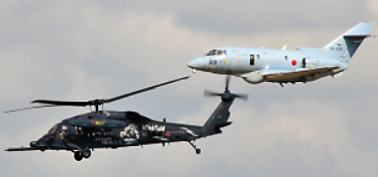 (Photo: JASDF Ashiya AB)
(Photo: JASDF Ashiya AB)
Surprisingly, J-HangarSpace has been unable to find any detailed images of the specially marked UH-60J (above). Held on March 3, 2012, the base anniversary ceremony was featured in the May 2012 issue of the now defunct Air World. The article shows that this aircraft also carried silhouettes, in this case in white of the helicopter types the Ashiya ARS has operated alongside their years in service. The inscription ‘50th Anniversary’ (in red and yellow, respectively) was carried on the fuel tanks.
July–Sept. 2021 60th Anniversary Ashiya AB/ARS
U-125A 42-3022 / UH-60J 58-4594
As mentioned and illustrated in the Bulletin Board entry for July 15, 2021, the Ashiya ARS used variations on its tiger unit marking to decorate these two aircraft.
 A close-up photo of the specially black tiger-striped U-125A; note that the red ‘A’
A close-up photo of the specially black tiger-striped U-125A; note that the red ‘A’
completes U-125A and the unit wording on the front fuselage.
(Photo: JASDF/Ashiya AB via Twitter @jasdf_ashiya)
 On the right side, the tiger’s head design could even be a highly stylized map of
On the right side, the tiger’s head design could even be a highly stylized map of
Kyushu, with the yellow triangular eye indicating Ashiya’s location.
(Photo: JASDF/Ashiya AB via Twitter @jasdf_ashiya)
 (Above and below) Although you might think that these photos of the left side of the two aircraft
(Above and below) Although you might think that these photos of the left side of the two aircraft
show them in flight unusually before the finishing touches had been applied, they were taken
when the designs were in the process of being removed. Photographed on September 1, the
U-125A lacks the red ‘A’; the day before, the “UH-60” has white-only tiger stripes and the
fuselage and fuel tank lettering look like unfinished crossword puzzle clues.
 (Photos: まえちゅう@解離性被害の飛行機via Twitter @reborn_genkai15)
(Photos: まえちゅう@解離性被害の飛行機via Twitter @reborn_genkai15)
 For comparison, an Ashiya ARS U-125A in standard markings
For comparison, an Ashiya ARS U-125A in standard markings
(Photo [Tsuiki, Oct. 2012]: ‘Amayagan’ via Wikimedia Commons)
CHITOSE
(Formed as Chitose Rescue Detachment Feb. 1, 1959,
redesignated Chitose ARS Dec. 1, 1964)
 A Chitose-based U-125A deploys a signal flare canister specially designed for airdrops during
A Chitose-based U-125A deploys a signal flare canister specially designed for airdrops during
maritime rescue operations. Weighing 7kg (around 15lbs), this type is made by a Tokyo-based
company called Hosoya Pyro-Engineering. (Photo: Japan Ministry of Defense/JASDF)
In the case of Chitose, nearly six years were to elapse between its formation as the first JASDF’s air rescue detachment on February 1, 1959, and its re-designation as an air rescue squadron December 1, 1964. It was during that time, on July 15, 1961, that its parent organization changed its name for the first time, from Air Rescue Squadron to Air Rescue Group.
In the meantime, the unit had recorded the rescue organization’s first, fortunately non-fatal accident, when an H-19C came down in the Saru district of Hokkaido Prefecture after hitting a tree on August 7, 1962.
The Chitose unit seems to have developed something of a tradition for being the first to operate a new type. This was the case with the S-62J (August 1963), MU-2/KV-107 (at same time as Komatsu, March 1968) and U-125A (March 1996).
Three Chitose-based JASDF pilots were lucky to survive a collision between their F-104J and T-33A near Rumoi, Hokkaido Prefecture, on April 26, 1967. Not only did they manage to eject safely, they also survived parachuting down into a snowcapped mountain range. Two pilots were rescued by their colleagues from the Chitose ARS, the other by the U.S. Army.
Chitose ARS Mission Episode
| Date | Notes |
| June 25, 1979 | Rescues one crew member from 302nd Sqn F-4EJ crew about an hour after he had ejected over the sea off Cape Erimo, Hokkaido Prefecture. (Other crew member picked up by JMSDF S-61A from Hachinohe) |
On September 1, 1983, a navigational error on the part of its flight crew resulted in Korean Airlines Flight KAL007 being shot down by a missile, fired by the pilot of a Soviet Air Force Sukhoi Su-15 interceptor, while en route from Anchorage, Alaska, to Seoul. The trigger for a tense political situation, this tragic incident took place over the Sea of Japan off the USSR island of Sakhalin. The Chitose ARS was one of the units called upon to join in the search for victims from the 269 people on board and for any wreckage.
Thirty years after that first accident, in July 1992, the unit received its first UH-60J, but tragedy was to strike on December 2, 1994, when an aircraft of this type crashed on Mt. Yurappu. The ill-fated crew, all five of whom perished, had been en route to the island of Okushiri on an emergency patient airlift mission.
In the early hours of November 13, 2004, strong winds forced the 5,500-ton South Korean freighter Marine Osaka onto a breakwater at Ishikari port, prompting the Chitose ARS’s involvement in a major combined JASDF-Japan Coast Guard rescue operation. According to reports, of the 16-man crew from South Korea and Myanmar, eight were rescued from the water and seven from a cabin ladder as the ship broke up, but tragically six of them were later confirmed to have lost their lives.
A photo in a report in the July 2009 issue of Kōkū Fan magazine shows that, as at March 10 in that its 50th anniversary year, the Chitose ARS had rescued 43 people on 43 air rescue missions and 389 people in the course of 198 disaster relief missions; a cumulative total of 175 emergency airlift missions had also been carried out. As at April 1 that year, the unit had surpassed 25,200 accident-free flying hours. Coinciding with the anniversary, a monument inscribed with the Japanese for “Lest We Forget”—and including one of the joysticks from UH-60J ’554—was erected in the entrance lobby of the squadron building in memory of the crew members who had lost their lives in the line of duty in the 1994 accident.
The vast majority of Chitose ARS operations involve the emergency airlift of patients and casualties to hospital. For example, the Air Rescue Wing website outlines eight missions in 2018 and five in the first three months of 2019 alone; all of the missions in 2018 and two of those in 2019 involved the use of a U-125A, a type that first entered service with the unit in March 1996.
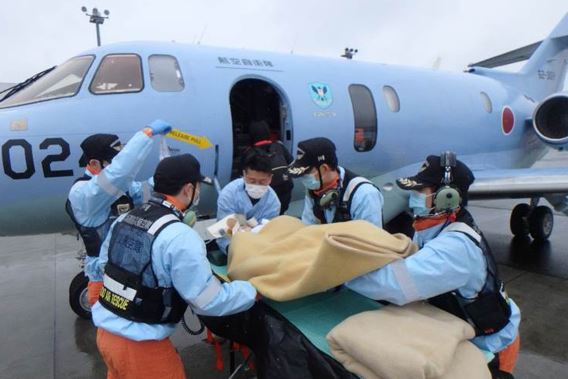 A Chitose-based U-125A is used to airlift an emergency hospital case from Hakodate airport to
A Chitose-based U-125A is used to airlift an emergency hospital case from Hakodate airport to
Okadama airport. (Photo [Apr. 6, 2018]: Japan Ministry of Defense/Air Rescue Wing)
From September 6 to October 14, 2018, the Chitose ARS worked in conjunction with the Iruma- and Misawa-based heavy-lift helicopter units in responding to the Hokkaido Eastern Iburi Earthquake.
CHITOSE ARS SPECIAL MARKINGS
August 1979 Chitose Airshow ‘Superman’ KV-107II-5 04-4814
The second photo here (link) shows an early example of a special marking applied for publicity purposes.
August 2007 Chitose AB 50th Anniversary U-125A 52-3023 (link) (link) / UH-60J 38-4557 (link)
 (Photo: 100yen via Wikimedia Commons)
(Photo: 100yen via Wikimedia Commons)
As reported in the October 2007 issue of Kōkū Fan magazine, the specially decorated Chitose ARS U-125A (above) made a big impression, at little cost to the taxpayer, at that year’s air show. The aircraft carried cut-out sticker versions of the base’s 50th anniversary Hokkaido map emblem on its fuselage and of the official logo on its tail; ‘Hokkaido’ appeared on a stripe at the top of the tailfin. An otherwise standard yellow UH-60J had the logo badge towards the rear of green-painted tanks and the earlier version of the unit badge, a map of Hokkaido carried in a sling, towards the front.
June-December 2008 Air Rescue Wing 50th Anniversary UH-60J 48-4559
The Chitose ARS’s contribution to the combined efforts that produced no less than six aircraft decked out in the same scheme. The aircraft in question is seen here (link) at its home base in August 2008 and here (link) at Niigata in December 2008.
April/August 2009 Chitose ARS 50th Anniversary U-125A 52-3002 (link) / UH-60J 18-4574 (link)
Befitting of the Chitose ARS’s 50th anniversary, an aircraft of each type was decked out in a striking colour scheme in time for the official ceremony, which was held in April 2009. The unit badge had newly had the face of an owl—to be exact a Blakiston’s fish owl, a species native to Hokkaido—and a red cross, showing Chitose’s location, added within the map of the island prefecture. Both aircraft carried the silhouette of an owl in white on their tails.
 The UH-60J that was specially painted for the Chitose ARS 50th anniversary in standard markings.
The UH-60J that was specially painted for the Chitose ARS 50th anniversary in standard markings.
(Photo: Japan Ministry of Defense/JASDF)
August 2019 Chitose Airshow Chitose ARS 60th Anniversary
U-125 42-3022 / UH-60J 48-4580 (Video at [link])
 (Photo: Wilco via Twitter @Wilco11886715)
(Photo: Wilco via Twitter @Wilco11886715)
 (Photos: CJ via Twitter @armingarea1836)
(Photos: CJ via Twitter @armingarea1836)

July 2022 Chitose Airshow Chitose 96th Anniversary
U-125 92-3012 (link) / UH-60J 78-4584
 Both Chitose ARS aircraft carried two stickers. The upper disc contained the “Connecting people,
Both Chitose ARS aircraft carried two stickers. The upper disc contained the “Connecting people,
Connecting the world: Sky Town Chitose” slogan of the City of Chitose’s latest PR campaign,
hence the “7th Comprehensive Plan” in English that appeared at the base of the disc. The self-
explanatory 96th Anniversary design on the lower sticker commemorated the day in 1926, when
local residents of what was then Chitose village cleared a landing field to receive the first civil
aircraft seen in the area. (See Chitose entry on JASDF Base Histories page.) More obscurely,
the number ‘96’ was also a reference to the year 1996, when a second runway was completed,
thereby allowing separate civil-military operations; presumably the ‘6’ was highlighted as
2022 marks the sixth anniversary of that event.
A variety of other aviation-themed events were planned to coincide with the airshow.
 (Photos: [Top, Matsushima, July 2022] m-works via Twitter @ascot017;
(Photos: [Top, Matsushima, July 2022] m-works via Twitter @ascot017;
[above] JASDF Chitose AB via Twitter @jasdf_chitose)
July 2023 Chitose Airshow Chitose 97th Anniversary UH-60J 78-4584
 A close-up of the slightly revised special marking on the UH-60J paraded for the
A close-up of the slightly revised special marking on the UH-60J paraded for the
press prior to the Chitose 2023 air show; see July 2023 Bulletin Board story.
(Photo [July 18, 2023]: JASDF Chitose via Twitter @jasdf_chitose)
HAMAMATSU
(Provisional ARS formed Mar. 18, 1958;
ARS (1) formed Oct. 1, 1958; ARS (2) formed Mar. 1, 1971)
 The last JASDF KV-107IIA-5 in a typical pose during its final display at Iruma, November 3, 2009.
The last JASDF KV-107IIA-5 in a typical pose during its final display at Iruma, November 3, 2009.
Delivered to the service early in March 1987, the aircraft had been on a sayonara tour in 2009 and
completed its final air rescue display at its Hamamatsu base four days before, on October 30.
 The first KV-107II for Hamamatsu, a KV-107II-5, arrives at the base in 1971. This aircraft
The first KV-107II for Hamamatsu, a KV-107II-5, arrives at the base in 1971. This aircraft
was destined to be written off while assigned to the Komatsu ARS in May 1978.
(Photo: JASDF Hamamatsu AB)
Hamamatsu was the setting for the formation of the JASDF’s sole Rinji Kyūnan Kōkūtai (Provisional Air Rescue Squadron) on March 15, 1958. Dropping the “provisional” title, the squadron was joined by a newly formed Kyūnan Kyoikutai (Air Rescue Training Squadron) and a maintenance unit on October 1 that year. The base thus assumed overall command of the air rescue set-up, but this was to be a short-lived responsibility as the headquarters functions were relocated to Iruma on July 1, 1960.
All air rescue detachments having been re-designated as squadrons on December 1, 1964, after an absence of nearly 11 years today’s Hamamatsu ARS was formed as a knock-on effect of the relocation of the Air Rescue Training Squadron from Hamamatsu to Komaki on March 1, 1971. The ousted former Komaki squadron moved in the opposite direction that very same day, on which the Air Rescue Group was itself renamed the Air Rescue Wing.
One of the unit’s pilots was killed and another injured when their T-6G crashed in the mountainous district of Minamisaku in Nagano Prefecture on September 22, 1965.
A mere six months or so after regaining its front-line rescue role, on October 22, 1971, the Hamamatsu ARS received its first KV-107II to start the replacement of its S-62Js, and deliveries to the unit of the more capable successor to the T-34A, the MU-2S, commenced in February 1972. The last Hamamatsu-based S-62J was retired on December 19, 1974, but the T-34A was to soldier on until April 27, 1982.
An article in the July 2007 issue of the Japanese magazine Aireview reported that, in the 36 years from its formation to January 2007, the unit had carried a total of 25 rescue missions and been desptached on disaster relief missions on 149 occasions. A brief overview of those missions in the early 2000s mentioned in the article appears in tabular form below.
| Year | Mission/Event |
| 2001 | Related to previous year’s evacuation of Miyake Is., part of the Izu Island chain, after volcanic eruption |
| Earthquakes in Shizuoka, Aichi and Yamanashi prefectures | |
| 2002 | South Korean ship sinking off Omaezaki, Shizuoka Prefecture |
| Search for light aircraft in Yamanashi Prefecture | |
| Sea search off Maisaka, Shizuoka Prefecture | |
| 2003 | Ship sinking off Kushimoto, Wakayama Prefecture |
| 2004 | Chubu Earthquake (Mie Prefecture) |
| Chuetsu Earthquake, flooding (Niigata Prefecture) | |
| JGSDF AH-1S accident | |
| 2005 | JGSDF OH-6D accident |
| 2006 | Post-earthquake reconnaissance, Atami, Shizuoka Prefecture |
| Search for swimmer off Niihama, Ehime Prefecture |
The unit conducted its last MU-2A/KV-107IIA-5 demonstration flight on October 5, 2008, the MU-2S then making its last flight on the 22nd of that month. The first UH-60J had arrived on February 21, 2007.
 A Hamamatsu ARS crew puts a UH-60J through its paces at the Shizuhama AB air show, May 2012.
A Hamamatsu ARS crew puts a UH-60J through its paces at the Shizuhama AB air show, May 2012.
As part of its long-running series on people who risk their lives at work, News Tokyo featured another UH-60J pilot, flight group commanding officer Major Shigeru Ootagaki, in an article in 2015. He was one of the pilots scrambled in response to the massive eruption of Mt. Ontake on September 27, 2014, which claimed the lives of more than 60 people and injured around 70.
Although it had been a fine day on the mountain, which straddles Gifu and Nagano prefectures around 200 km (120 miles) west of Tokyo, the eruption of smoke and vapour had rapidly changed the scene to worse than white-out conditions. Normally, the Hamamatsu ARS is responsible for the area from Mie Prefecture to Kanagawa Prefecture, the area around Tokyo being the responsibility of Hyakuri ARS in Ibaraki Prefecture far out to the east.
Having made straight for the summit area to airlift out one casualty, the extrication had to be completed in double-quick time due to the double threat posed by the steam still being expelled and by the volcanic ash that would have serious consequences if ingested by the engines. Ootagaki said that the combination of the distance from base, the extreme conditions and the difficulties in controlling the helicopter at its performance limits made for an operation that wore down nerves.
That was the only mission flown to Mt. Ontake, as the article describes the ARSs as saigo no toride (“the last bastions”), meaning their more advanced helicopters operate strictly in support of local government helicopter rescue and police units on land and of the Japan Coast Guard at sea. Hence the number of such missions undertaken by the ARSs in a year is small but likely to be extreme in nature, when the civilian units’ helicopters are unavailable due to operational reasons, cannot cope with the conditions or are already stretched to the limit.
Torrential rainfall and flooding on September 10, 2015, initially involved a major mobilization of JGSDF units but resulted in a Hamamatsu ARS UH-60J working alongside a U-125A and UH-60J from the Hyakuri ARS. That very day, a special rain warning was issued in parts of Ibaraki Prefecture and the situation deteriorated when the Kinu River burst its banks. Operating in the Motoishige district of the worst-hit city of Joso until sunset, the crews succeeded in airlifting 90 stranded people to the safety of a park area. A repeat performance from sunrise to sunset the following day increased the total number of people airlifted to 141 before two days on standby in bad weather was followed by the ARS operation being called off on September 13.
 Interviewed on the Air Rescue Wing website in 2017, 2nd Lt. Yūta Nozaki said that he had just
Interviewed on the Air Rescue Wing website in 2017, 2nd Lt. Yūta Nozaki said that he had just
qualified as a pilot when called upon to fly one of the Hamamatsu-based UH-60Js during the
flood rescue efforts in Joso, Ibaraki Prefecture, in September 2015. In the interview, he
describes the sense of achievement he derived from seeing the relieved expressions on the
faces of those he and his crew had brought to safety. (Photo: JASDF Air Rescue Wing)
Sadly, the Hamamatsu ARS’s recent history has been overshadowed by the loss of the crew that was flying the second of the JASDF’s modernized UH-60J-IIs on October 17, 2017, during a training exercise involving the wearing of night vision goggles (NVG). A search operation was set in motion after radar contact was lost only 10 minutes after departure, and flotsam found that same night, but it was not until an underwater search and salvage operation was conducted in November and December that the bodies of three of the four crew members and the wreckage of the aircraft, complete with its flight data and cockpit voice recorders, could be recovered. Published in a press release issued on February 14, 2018, the combination of factors that led to the accident was found to have been insufficient confirmation of the aircraft’s altitude and sink rate due to loss of spacial awareness (the pilot in command had decided to descend to avoid clouds barring the route), poor intracrew communications and, crucially, the distracted pilots taking no action in the 45 seconds from the radio altitude alert sounding at around 250 feet and the aircraft impacting with the sea.
On January 30, 2018, a funeral service was held at Hamamatsu AB for the four who had lost their lives: pilots Maj. Akihiro Hanafusa (42) and Maj. Hideaki Sugimoto (46), flight engineer Tech Sgt. Takanobu Yoshida (40), and rescuer Staff Sgt Masafumi Inoue (32).
In June 2017, the Hamamatsu ARS had successfully participated in two typical operations. On June 13, acting in response to a request from the Japan Coast Guard’s 5th Region, a U-125A and UH-60J were instrumental in airlifting an emergency case from a ship lying nearly 300 nautical miles (600 km) off Cape Shionomisaki, Wakayama Prefecture. On June 25, a U-125A was launched to gather damage assessment information following an earthquake that had struck the city of Iida, Nagano Prefecture, earlier that morning.
In the early hours of December 6, 2018, Hamamatsu U-125A and UH-60J crews worked in conjunction with their ARS counterparts at Ashiya and Nyutabaru as well as with the Japan Coast Guard and U.S. and Australian units in a protracted and extensive search operation. Five crew members of a U.S. Marine Corps KC-130J were declared missing after a nighttime midair collision with an F/A-18 Hornet 55 nautical miles (100 km) south of Cape Muroto, Kochi Prefecture; only one of the latter’s two-man crew survived. The search was finally called off early on December 11.
 Hamamatsu ARS U-125A crew members at the “office”. Underneath the unit insignia, the
Hamamatsu ARS U-125A crew members at the “office”. Underneath the unit insignia, the
blue sticker commemorating the JASDF’s 60th anniversary dates this photo in 2014.
(Photo [Hamamatsu, Oct. 2014]: Andy Binks)
 An event to mark the Hamamatsu ARS’s golden jubilee was held at the base on
An event to mark the Hamamatsu ARS’s golden jubilee was held at the base on
March 6, 2021. (Photo: JASDF Hamamatsu AB)
HAMAMATSU ARS SPECIAL MARKINGS
June 1994 Experimental Grey Colour Scheme MU-2S 23-3226 (link)
Although seen at the Komatsu airshow, this unusually painted aircraft was assigned to the Hamamatsu ARS.
March 2001 Hamamatsu ARS 30th Anniversary KV-107IIA-5 54-4836 (link)
October 2004 JASDF 50th Anniversary KV-107IIA-5 04-4852 (link)
According to 50th Anniversary of JASDF (Bunrindo, 2005), a five-man team started work on applying the special colour scheme on June 9, 2004, and finished around two weeks later. By chance, the last of the 52 KV-107IIs delivered to the JASDF happened to be assigned to the unit at that time.
The plan was to mark the JASDF’s 50th anniversary by painting one example of each the five types then in ARS service (including a KV-107IIA-5, despite its gradual retirement, and a Helicopter Airlift Squadron CH-47J) in a common colour scheme. The concept of the winning design, chosen from the 140 suggestions received, involved painting the tails of the aircraft navy blue, grey and white in sequence from the rear forward to symbolize sea, sky, and cloud, respectively. In the case of the KV-107II, the colour sequence was carried over to the sponsons. An ARW eagle heading out on a rescue mission was depicted on the tail and the ARW badge on the rear fuselage had five white stars added in an upward-pointing arc underneath to symbolize the five aircraft types.
The other ARSs involved in this project were Komatsu (UH-60J), Matsushima (U-125A), and Niigata (MU-2A) as well as the Iruma Helicopter Airlift Squadron (CH-47J). Thus only an official commemorative sticker was applied to a Hamamatsu MU-2A (link).
May-June 2008 Air Rescue Wing 50th Anniversary MU-2A 63-3228 (link) (link) / U-125A 12-3016
For this important milestone, a distinctive blue eagle design was applied to a Hamamatsu-based MU-2A, which did the rounds of other JASDF bases in the run-up to its retirement that October. Hamamatsu also contributed a U-125A to match that provided by the Akita ARS; this photo (link) shows the aircraft on takeoff from Niigata in August 2008. Other aircraft, such as this U-125A (link), merely carried a 50th anniversary badge for the duration.
March 2011 Hamamatsu ARS 40th Anniversary U-125A 82-3008 (link) (link)
The unit having adopted Mount Fuji as its badge, this formed the basis of its 40th anniversary colour scheme. The design doffs a cap to the artist Hokusai’s 1830s woodblock print The Great Wave off Kanagawa from Thirty-six Views of Mount Fuji. The base name was applied in yellow on the engines.
October 2011 Hamamatsu Air Festa UH-60J 18-4574 (link) (link)
U-125A 52-3002 (link) (link)
This was the year in which the Great East Japan Earthquake had claimed many lives and wreaked havoc in the Tohoku region as well as triggerrd the tsunami that culminated in meltdowns at the Fukushima nuclear power plant. The UH-60J thus carried the encouraging slogan がんばろう! 日本 (Ganbarō! Nippon, Hang in There Japan!) on both sides of its fuselage. The Mount Fuji design was blue on the left side and red on the right; note the base name on the fuel tanks. The U-125A had variations on the slogan theme and the base name in hiragana script はままつ on its engines. Other views of both aircraft can be found here (link).
February 2021 Hamamatsu ARS 50th Anniversary
U-125A 52-3023 (link) (link) / UH-60J 78-4603 (link) (link)
 The ornate design for the unit’s golden jubilee was a throwback to that for the
The ornate design for the unit’s golden jubilee was a throwback to that for the
40th anniversary in being based on Mt. Fuji. (Photos: くまブルー浜松 via Twitter @Kuma11blue)
(Photos: くまブルー浜松 via Twitter @Kuma11blue)
HYAKURI
(ARS formed Nov. 20, 1965)
 (Photo [Hyakuri, June 2019]: : ゆうさん via Twitter @akubicyandesu)
(Photo [Hyakuri, June 2019]: : ゆうさん via Twitter @akubicyandesu)
This the eighth unit to form adopted the mimizuku (horned owl) as its squadron marking to symbolize its day and night rescue operations.
Officially coming under the command of the then Air Rescue Group on November 20, 1965, Japanese sources state that an air rescue squadron was formed at Hyakuri on February 1 that year. Throughout the occasional changes to its command structure, the most recent being the Air Rescue Wing’s transfer from Air Support Command to come under the direct control of Air Defense Command in March 2013, the squadron has remained a permanent fixture at Hyakuri.
In its formative years, the unit experienced its share of flight safety concerns. The crew of an H-19C that came down in Lake Kitaura, Ibaraki Prefecture, on February 2, 1967, were lucky to escape unhurt, and it was a Hyakuri-based T-34A that crashed in the mountains of Kitaibaragi on August 25, 1969.
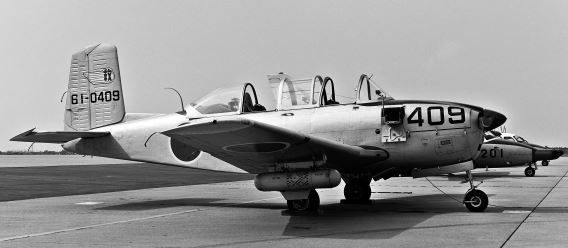 An ARS T-34A on the flight line at Hyakuri in late October 1972; the nose of the first MU-2S
An ARS T-34A on the flight line at Hyakuri in late October 1972; the nose of the first MU-2S
built is just visible in the background. (Photo: Akira Watanabe)
 Fast forward 13 years, and a Hyakuri ARS MU-2S is seen making its way along the
Fast forward 13 years, and a Hyakuri ARS MU-2S is seen making its way along the
taxiway in June 1985. (Photo: Akira Watanabe)
Operations in 2015 included the involvement of a U-125A and UH-60J from the Hyakuri ARS in the major four-day operation that followed torrential rainfall and flooding in September (as related in the Hamamatsu ARS section). In August the following year, the unit was called upon by the Japan Coast Guard to assist in the search for the four occupants of a pleasure boat missing off the coast of Choshi, Chiba Prefecture.
 A Hyakuri-based U-125A undergoes maintenance checks at Iruma in November 2009.
A Hyakuri-based U-125A undergoes maintenance checks at Iruma in November 2009.
The Hyakuri ARS assisted in the making of the TV drama adaptation of Hiro Arikawa’s prize-winning novel Soratobu Kōhōshitsu (Public Affairs Office in the Sky), which aired for 11 episodes in 2013.
 March 25, 2020. Scenes during (above) and at Hyakuri towards the end of the resident ARS’s
March 25, 2020. Scenes during (above) and at Hyakuri towards the end of the resident ARS’s
involvement in a mission conducted at the Japan Coast Guard’s request. Working in concert
with a Matsushima-based U-125, a UH-60J crew had successfully flown to the assistance
of a seaman on board a tuna fishing vessel 260km off Choshi, Chiba Prefecture.
 (Photos: [top] Japan Ministry of Defense/JASDF Air Rescue Wing;
(Photos: [top] Japan Ministry of Defense/JASDF Air Rescue Wing;
[above] JASDF Hyakuri AB via Twitter @jasdf_twitter)
HYAKURI ARS SPECIAL MARKINGS
July 1994 JASDF 40th Anniversary MU-2S 13-3211 (link) / KV-107IIA-5 74-4825 (link)
Both aircraft sported chic green fuselage stripes, with an eagle marking on the tail.
October 1997 Air Rescue Wing 40th Anniversary MU-2A 23-3226
Although hard to make out, the MU-2A in this shot (link) taken at the 1997 Hyakuri airshow carries the badge designed for the 40th anniversary of the ARW.
October 2015 Hyakuri ARS 50th Anniversary U-125A 12-3018 / UH-60J 08-4572
Both aircraft (link)
 (Above and below) The design carried on both sides of the specially marked U-125A’s fuselage in
(Above and below) The design carried on both sides of the specially marked U-125A’s fuselage in
2015 comprised the unit badge of a horned owl, with its wings spread flying through red and
pink plum blossom, above a pink-shadowed white ’50th anniversary’. (Photos: David Cook)
The same design was carried by the UH-60J (link), with the wording applied to the fuel tanks.

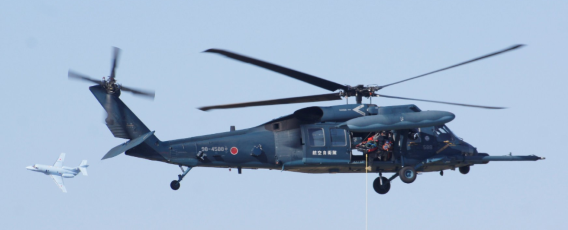 (Photo: JASDF Hyakuri AB)
(Photo: JASDF Hyakuri AB)
IRUMA
(Detachment formed Jan. 25, 1963, ARS disbanded Oct. 1, 1968)
In the musical chairs-like base changes in the JASDF’s formative years, Iruma assumed overall command of the air rescue organization when the HQ functions were moved from Hamamatsu on July 1, 1960.
Its own short-lived, initially detachment-level unit formed on January 25, 1963, and was upgraded to squadron status along with the others on December 1, 1964, only to be disbanded less than four years later.
Tragically, on September 15, 1964, only five days after the loss of Ashiya-based personnel in an H-21B crash, all six men on board an Iruma H-19C were killed when their aircraft came down in a rice field in Iwatsuki (now part of Saitama City), Saitama Prefecture.
KOMAKI
(Detachment formed May 15, 1959, ARS disbanded and relocated to Hamamatsu Mar. 1, 1971)
Komaki Air Rescue Training Squadron
(Formed Mar. 1, 1971)
 A Komaki-based UH-60J in the earlier yellow-and-white colour scheme inherited from its
A Komaki-based UH-60J in the earlier yellow-and-white colour scheme inherited from its
predecessor, the KV-107II. (Photo [Komaki, Oct. 2006]: ‘Itachi’ via Wikimedia Commons)
 Previous generations of JASDF rescue helicopter at Komaki were the S-62J (above, photographed
Previous generations of JASDF rescue helicopter at Komaki were the S-62J (above, photographed
in August 1980) and KV-107II (below, July 1994). (Photos: Akira Watanabe)

 In 2021, Komaki will likely be marking its half-century as home to the Air Rescue Wing’s
In 2021, Komaki will likely be marking its half-century as home to the Air Rescue Wing’s
training element, which should prompt the design of a special aircraft marking.
(Photo [Komaki, March 2018]: Hunini via Wikimedia Commons)
KOMATSU
(Detachment formed Mar. 1, 1961,
redesignated ARS Dec. 1, 1964)
 The dropping of rescue equipment, in this case a survival kit, forms a regular part of the U-125A
The dropping of rescue equipment, in this case a survival kit, forms a regular part of the U-125A
display at Komatsu air shows. (Photo [Sept. 2014]: 藤谷良秀 (Yoshihide Fujiya?)
via Wikimedia Commons)
The fifth unit to form, that at Komatsu adopted as its emblem the mask from kagajishi, the name by which the traditional lion dance is known locally in Kanazawa, Ishikawa Prefecture.
Surprisingly, J-HangarSpace has been unable to ascertain the exact date of an incident involving a Komatsu ARS S-62J. The aircraft is pictured looking very sorry for itself sitting on the water but with its tail completely sheared off in Kōkū Fan Illustrated No. 108 (p. 61). The photo caption puts the time as ‘late fall in the mid-1960s, soon after the S-62’s deployment’ and gives the location as Imaegata, a stretch of water close to the Komatsu base that was later reclaimed for agricultural use. The story goes that the crew were practising water landings when the tail boom came into contact with the lake’s surface.
Komatsu ARS Mission Episodes
| Date | Notes |
| Feb. 21, 1966 | Rescues 12 crew members from cargo ship that had run aground at Maisaka in city of Hamamatsu, Shizuoka Prefecture |
| Oct. 19, 1970 | Rescues two fishermen stranded on rock wall near Saruyama lighthouse, Wajima, Ishikawa Prefecture |
On October 29, 1969, the crew flying the JASDF’s second KV-107II-5 were lucky to escape unscathed after crash landing on the Komatsu runway.
On May 11, 1978, another KV-107II-5 crew had a narrow escape. They were sent on a late afternoon mountain rescue mission to to pick up five climbers who had become incapacitated due to fatigue near the summit of Yarigatake, on the Nagano-Gifu prefectural border. As reported in the August 1978 edition of the Japanese magazine Aviation Journal (link), the aircraft was caught in turbulence and toppled over onto the roof of a mountain lodge. Its two fuel tanks and of course rotors were ripped off on impact and that part of the lodge’s damaged, but the four-man crew and those in the building were unscathed. The sad coda to this story is that another helicopter ended up being sent the following day to retrieve the bodies of the five climbers who had since perished.
 (Photo [Komatsu, November 1994]: Rob Schleiffert)
(Photo [Komatsu, November 1994]: Rob Schleiffert)
First broadcast in 2006, a 13-episode TV anime series set in an air rescue squadron was entitled Yomigaeru Sora—Rescue Wings; the Japanese part of the title could be translated as ‘reanimated sky’.
For publicity and recruitment purposes, three ARS bases (Hamamatsu, Hyakuri and Komatsu) were used to shoot scenes for the follow-up 2008 live action film simply called Rescue Wings. As mentioned in the 2009 edition of the white paper Defense of Japan, the film starred the young actor Yūko Takayama as a UH-60J rescue pilot. (Although there have been women UH-60J pilots in the JMSDF, it remains an area of JASDF operations into which women have yet to make inroads.)
 Preparing to shoot a scene at Komatsu during the filming of Rescue Wings in 2008.
Preparing to shoot a scene at Komatsu during the filming of Rescue Wings in 2008.
(Photo: Japan Ministry of Defense)
In June 2014, Komatsu ARS crews underwent their first helicopter air-to-air refuelling (HAAR) training mission over the Sea of Japan with the U.S. Air Force’s 353rd Special Operations Group (SOG).
 Somewhere over the Sea of Japan, Komatsu ARS crews participate in their first daylight HAAR
Somewhere over the Sea of Japan, Komatsu ARS crews participate in their first daylight HAAR
training in June 2014 (above) and prepare for their first nighttime training in June 2017 (below).
Part of Teak Jet, a joint combined exchange training exercise, the latter also called for crews
to don night vision goggles when formating with an MC-130H Combat Talon II of the
U.S. Air Force’s 353rd SOG. This was the first night HAAR training for Japanese
mainland-based JASDF UH-60J crews.
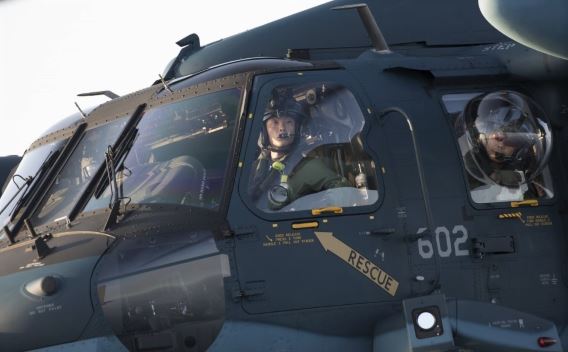 (Photos: U.S. Air Force/Yasuo Osakabe, 374th AW Public Affairs)
(Photos: U.S. Air Force/Yasuo Osakabe, 374th AW Public Affairs)
Staying on the subject of joint U.S.-Japan training, the Komatsu ARS participated in the training exercise Keen Sword 2015, which was held in November 2014. The air rescue/natural disaster training missions also involved a US-2 from the JMSDF’s 71st Fleet Air Squadron and elements from two U.S. Air Force rescue squadrons, the 33rd RS from Kadena AB in Okinawa and the 212th RS from Eielson AB, Alaska. The Komatsu ARS also took part in the Cope North Guam exercises in both 2016 and 2017.
 Participants pose for a photo call at Komatsu at the start of the four-day joint U.S.-Japanese
Participants pose for a photo call at Komatsu at the start of the four-day joint U.S.-Japanese
training exercise Keen Sword 2015. (Photo [Komatsu, Nov. 16, 2014]: Japan Ministry of Defense)
Elsewhere in this section are links to photos of various camouflage schemes that have occasionally been applied to air rescue aircraft, either on an experimental basis or for a specific temporary purpose. In 2016, two Komatsu-based U-125As appeared in a dark-blue scheme—similar to that of the UH-60Js—for the combat search and rescue (CSAR) mission, for which they were also equipped with aircraft survival equipment, including a wingtip-mounted missile warning system and fuselage-mounted chaff/flare dispensers.
 Following the first flight of a U-125A specially equipped for the CSAR role on April 10, 2016
Following the first flight of a U-125A specially equipped for the CSAR role on April 10, 2016
(see Bulletin Board), this second aircraft appeared that July.
(Photo [Komatsu, June 2017]: Z3144228 via Wikimedia Commons)
In June 2017, the Komatsu ARS worked with its counterparts at Niigata in locating the wreckage of a Cessna 172 that had struck and slid partway down Mt. Shishidake in Toyama Prefecture in poor visibility, killing all four occupants.
Other recent search and rescue operations include the launch of a U-125A and UH-60J to gather damage assessment information in the aftermath of the earthquake that struck northern Osaka Prefecture on June 18, 2018.
 (Photo: Japan Ministry of Defense)
(Photo: Japan Ministry of Defense)
On January 16, 2019, the unit also received a request from the Japan Coast Guard to send aircraft to assist the eight-man crew of a trawler (above) that had run aground off the port of Wajima, Ishikawa Prefecture. According to the Ministry of Defense press release detailing events, the U-125A took off at 06:17 and the UH-60J around 10 minutes later, the actual rescue commenced soon at 07:08, and all the trawler’s crew had been safely airlifted back to a baseball ground in Wajima (below) for onward transport to hospital at 07:43.
 (Photo: Japan Ministry of Defense)
(Photo: Japan Ministry of Defense)
On the night of May 1, 2019, the first day of the new Reiwa era, a U-125A and UH-60J were sent to coordinate and execute the airlift to Komatsu airport of a sick crew member from a container ship 60 nautical miles (30 km) off the Noto Peninsula. The following day, a glider made an emergency landing on Mt. Yake, about 20 miles (32 km) west of Matsumoto airport, Nagano Prefecture, which resulted in a two-aircraft Komatsu team again working in conjunction with a Niigata UH-60J crew.
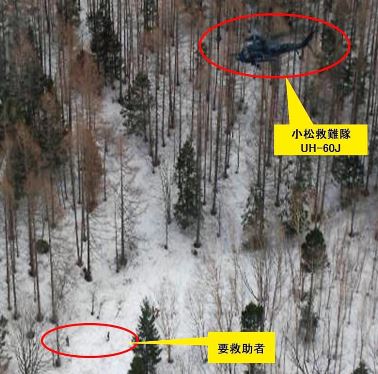 Taken near the successful conclusion of a rescue operation on May 3, 2019, this photo has circles
Taken near the successful conclusion of a rescue operation on May 3, 2019, this photo has circles
to indicate the Komatsu ARS UH-60J and the two survivors of a gliding incident on Mt. Yaki
in the Northern Alps. (Photo: JASDF Air Rescue Wing)
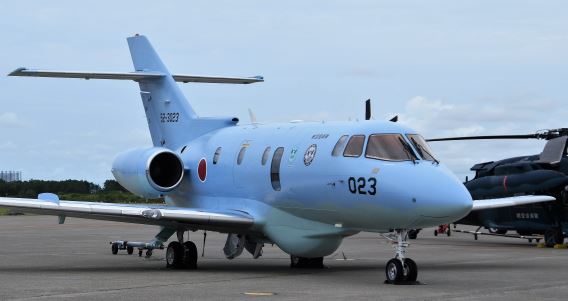 A Komatsu-based U-125A carries the badge proclaiming the Air Rescue Wing’s 60th anniversary;
A Komatsu-based U-125A carries the badge proclaiming the Air Rescue Wing’s 60th anniversary;
see Bulletin Board entry for June 2, 2018.
(Photo [Komatsu, September 2018]: Hunini via Wikimedia Commons)
 To little outside publicity and with apparently no special aircraft markings, the Komatsu Air Rescue
To little outside publicity and with apparently no special aircraft markings, the Komatsu Air Rescue
Squadron held an event to mark its 60th anniversary on November 20, 2021. Having had a dark
blue “combat” scheme applied in 2016, as seen previously on this page, the U-125A in this
photo had been reverted to the standard scheme by January 2019.
(Photo: JASDF Komatsu AB via Twitter @JasdfKomatsu)
KOMATSU ARS SPECIAL MARKINGS
 Strictly for static display purposes only, a Komatsu ARS KV-107IIA-5 was decorated with
Strictly for static display purposes only, a Komatsu ARS KV-107IIA-5 was decorated with
Doraemon cartoon characters at the base’s summer event in July 1986.
(Photo: Akira Watanabe)
November 1989 Special Camouflage Schemes
KV-107IIA-5 94-4827 (link) (link) / MU-2A 13-3209
A KV-107IIA-5 was given a special camouflage scheme for the 1989 TAC Meet, only for bad weather to result in the event’s cancellation. An MU-2S had been given an experimental camouflage scheme in time for that year’s airshow in June and was still in the scheme in November; the experiment might have eventually influenced the colours adopted for the U-125As.
October 2004 JASDF 50th Anniversary UH-60J 98-4569
This was one of the five aircraft given a common colour scheme (see Hamamatsu ARS).
September-October 2011 Komatsu AB/Air Rescue 50th Anniversary
U-125A 52-3003 / UH-60J 88-4587 (link)
 (Photo: 山猫 via Twitter @yamaneko804x4)
(Photo: 山猫 via Twitter @yamaneko804x4)
The U-125A initially only had an intricate tail marking of a grey kagajishi lion dance mask. This was joined by the UH-60J, again with a lion dance mask design on its tail, the post-Great East Japan Earthquake slogan meaning “Hang in There Japan!” on the side of the fuselage, beneath 航空自衛隊 (JASDF), and KOMATSU AIR BASE 50th Anniversary on the left fuel tank and KOMATSU AIR RESCUE 50th Anniversary on the right. The U-125A also went on to have KOMATSU AIR BASE 50th Anniversary added on its left engine and KOMATSU AIR RESCUE 50th Anniversary on the right.
March 2012 Komatsu Air Rescue 50th Anniversary UH-60J 08-4590 (link)
By the following spring, a different UH-60J was wearing the same markings, minus the fuselage slogan.
MATSUSHIMA
(Detachment formed Sept. 20, 1960,
redesignated ARS Dec. 1, 1964)
 The Matsushima ARS has been operating the UH-60J since the arrival of its first example, on
The Matsushima ARS has been operating the UH-60J since the arrival of its first example, on
March 11, 1999, and thus had been operating the type for exactly 12 years when
disaster struck in 2011. (Photo: JASDF Matsushima AB)
Today’s Matsushima ARS was the subject of a two-part article in the long-running That Others May Live series in the June and July 2016 issues of Kōkū Fan magazine.
A defining moment in the unit’s recent history came on March 11, 2011, when the base was engulfed by the tsunami triggered by the Great East Japan Earthquake. Whereas all the base personnel were able to seek refuge, all the ARS’s aircraft were affected to some degree. The two U-125As and four UH-60Js that were damaged beyond economic repair naturally included the duo on standby out on the alert apron; the force of the water wrought havoc, shunting those aircraft corralled inside hangars into each other or up against the walls.
Normally, the coastal base lies around seven feet, or just over two metres, above sea level. Although the tsunami was to reach a recorded height of more than 34 feet (10.3 metres) in the city of Higashi-Matsushima, just under a mile (1.5 km) inland, the flood depth at the base reached up more than 10 feet (3 m), in other words 17 feet (5 m) above sea level.
The following day, some ARS personnel were temporarily airlifted by CH-47J to Iruma. On March 13, others were moved either to Hyakuri to come under the command of the resident Hyakuri ARS or to Misawa, where an advanced guard from the Chitose ARS had been deployed.
Their aircraft being out of commission, the remaining personnel fulfilled their disaster relief role using Zodiac boats, for example ferrying residents to a local school that, as is the case all over Japan, doubles as a designated emergency evacuation centre. As the ARS’s former ground floor operations room had been devastated, they moved to that upstairs in the building formerly used by the 22nd Sqn, which had been vacant since that unit’s disbandment in 2001. It was from there that efforts to clean up and return the base and the unit to full operational status were coordinated; it was to be March 2016 before the resident 21st Sqn’s F-2Bs came back to the fold and everything was back in its proper place.
During a visit made in November 2012, personnel from the Akagi Kougyo equipment company learned that Herculean efforts had resulted in the runway being declared operational again on March 15, the Matsushima ARS following suit five days later. Two UH-60Js were flown in from other units on March 21, these being used on three concerted sweep searches for victims along the coast (April 1–3, April 10, and April 25–26) in between disaster relief and reconnaissance operations, which were officially declared at an end on August 31, 2011.
It was to be April 2013 before a rudimentary tented hangar was erected on the (now raised) apron to facilitate on-site maintenance; up to that time, helicopters due for maintenance work had simply been replaced. The first part of the Kōkū Fan article also mentions the opening ceremony, held on December 2, 2015, to mark the opening of the new administration building and hangar, which incorporate safety features based on the lessons learned from that fateful day. Pride of place in the administration building is given to a wooden frame, in which are mounted the manufacturer construction plates from the six ARS aircraft lost to the tsunami.
Originally the fourth such unit to form, on September 20, 1960, the Matsushima Rescue Detachment was sent on its first full-fledged mission, an air rescue, on December 13 that same year.
 A Matsushima H-19C flying in the vicinity of its home base
A Matsushima H-19C flying in the vicinity of its home base
(Photo [date unknown]: JASDF Matsushima AB)
The now ARS suffered its first loss of an aircraft on April 25, 1968, when its first S-62J crashed in the Tome district of Miyagi Prefecture, a month to the day after its arrival. Although the aircraft was written off, fortunately all the crew survived. The year 1968 also saw the curtain fall on T-6G operations (on November 30).
 The ill-fated first S-62J to be assigned to the Matsushima ARS at its handover
The ill-fated first S-62J to be assigned to the Matsushima ARS at its handover
ceremony, March 28, 1968. (Photo: JASDF Matsushima AB)
 The first Matsushima-based KV-107II-5 arrived on Valentine’s Day (February 14), 1970, a fitting date
The first Matsushima-based KV-107II-5 arrived on Valentine’s Day (February 14), 1970, a fitting date
for an aircraft type that would be held in great affection for more than 30 years.
(Photo [KV-107IIA-5]: JASDF Matsushima AB)
 The first of the KV-107II’s initial partner aircraft, the MU-2S, arrived on February 6 of the
The first of the KV-107II’s initial partner aircraft, the MU-2S, arrived on February 6 of the
following year, 1971. The slow phase-out of the later MU-2A commenced with the
arrival of the first U-125A, on March 9, 2000. (Photo: JASDF Matsushima AB)
 The pair of KV-107II-5s based at Matsushima basking in the sun in July 1975. The noses of the
The pair of KV-107II-5s based at Matsushima basking in the sun in July 1975. The noses of the
pontoon tanks were later painted black. Another photo evocative of the time, taken that same
month, shows an MU-2S (link) in front of the Matsushima ARS building, where the unit’s
flag is proudly fluttering in the breeze. (Photo: Akira Watanabe)
As time passed, the milestones of first 5,000 and then 20,000 accident free flying hours were passed on June 4, 1973, and February 3, 1983, respectively.
Matsushima ARS Mission Episode
| Date | Notes |
| Feb. 20, 1975 | Rescues all 20 crew from Philippines-registered vessel that had run aground and broken into two on Enoshima, an offshore island in Miyagi Prefecture |
The then new administrative block was completed on April 1, 1980, in time for the unit 20th anniversary celebrations on September 20 of that year. A new hangar eventually came on line in March 1994; these structures were destined to be ravaged by the 2011 tsunami.
U-125A 02-3013 was one of the two U-125As and 38-4578 one of the four UH-60Js written off on March 11, 2011, when caught in the tsunami at Matsushima.
 The Matsushima ARS was drafted in to assist with relief operations after the Yoshida River in Gifu
The Matsushima ARS was drafted in to assist with relief operations after the Yoshida River in Gifu
Prefecture burst its banks following a typhoon in 1986. During the course of the operation, the unit
plucked 14 people from the roofs of houses. (Photo [August 5, 1986]: JASDF Matsushima AB)
 A Matsushima ARS UH-60J moves towards the takeoff point in the shimmering heat of the July
A Matsushima ARS UH-60J moves towards the takeoff point in the shimmering heat of the July
2022 base airshow. All four types of the current and outgoing generations of rescue aircraft
were present that day.
 Disaster relief operations in the aftermath of the Iwate-Miyagi Nairiku Earthquake, which struck
Disaster relief operations in the aftermath of the Iwate-Miyagi Nairiku Earthquake, which struck
on June 14, 2008, included the rescue of passengers from an overturned bus.
(Photo: JASDF Matsushima AB)
Operations in recent years have included the following:
July 6, 2015. Following communications with the JASDF’s 4th Air Wing at Matsushima, an ill crew member is airlifted off the U.S. Coast Guard cutter Mellon that is then around 380 nautical miles (700 km) off the small island of Kinkasan, Miyagi Prefecture. The U.S. Coast Guard expresses its gratitude in a letter received a few days later.
 (Photo: JASDF Air Rescue Wing)
(Photo: JASDF Air Rescue Wing)
April 13, 2016. (Above) Having launched the standard pair of aircraft at the behest of the Japan Coast Guard’s 2nd Region, a Matsushima ARS UH-60J crew airlifts and brings back to base an injured seaman from a Chinese-registered vessel around 170 nautical miles (315 km) off Kinkasan.
May 2, 2018. The Miyagi Prefecture governor having formally lodged the request for despatch with the 4th Air Wing, a U-125A crew transports a patient from Matsushima AB to Kobe airport.
May 24, 2019. The request again having come from the Japan Coast Guard’s 2nd Region, a U-125A and UH-60J are launched to coordinate and effect the airlift as well as bring back to base a crew member from a ship lying 220 nautical miles (410 km) off the coast of Miyagi Prefecture.
 (Above and below) In the aftermath of Typhoon No. 19, Matsushima ARS UH-60Js conduct
(Above and below) In the aftermath of Typhoon No. 19, Matsushima ARS UH-60Js conduct
search and rescue operations in the town of Marumori, Miyagi Prefecture.
 (Photos [Oct. 13, 2019]: JASDF Matsushima AB)
(Photos [Oct. 13, 2019]: JASDF Matsushima AB)
October 19, 2020
 The scene aboard the JCG patrol vessel Kurikoma, which is homeported in Shiogama,
The scene aboard the JCG patrol vessel Kurikoma, which is homeported in Shiogama,
Miyagi Prefecture, as the hoisting operation commences. (Photo: JASDF/Air Rescue Wing)
Acting on information received via the 4th Air Wing the previous day, on October 19, 2020, a Matsushima ARS UH-60J was launched at around 10:40 at the behest of the Japan Coast Guard’s 2nd Region HQ. Accompanied by a doctor and nurse, its crews’ mission was to airlift back to Matsushima AB a sick fisherman from a Japanese trawler who had been transferred to a JCG patrol vessel. The operation took place about 180 nautical miles (300km) off Kinkasan, Miyagi Prefecture, around 90 minutes’ flight time from Matsushima for the UH-60J; the U-125A that was launched at 11:00, around 20 minutes after the UH-60J, arrived at the scene in less than 40 minutes. In around 20 minutes, the patient had been hoisted aboard the UH-60J and was en route to Matsushima AB, arriving at 13:50. The U-125A having arrived back half an hour previously, the operation was successfully wound up at around 14:00.
 Preparations are made to transfer the stretcher carrying the sick trawlerman to a waiting ambulance.
Preparations are made to transfer the stretcher carrying the sick trawlerman to a waiting ambulance.
(Photo [Oct. 19, 2020]: JASDF/Air Rescue Wing)
Attended by around 80 personnel, the ceremony to officially mark the 60th anniversary was held in a base hangar on September 18, 2020. According to a report by the Asagumo Shimbunsha news organization, squadron commander Lt. Col. Akira Hirayama stated in his address that the unit, which represented “the core of the rescue organization in the Tohoku region,” had been instrumental in helping to save many lives in the course of the 48 air rescue and 155 disaster relief missions that had been conducted.
 (Photo: JASDF Matsushima AB)
(Photo: JASDF Matsushima AB)
MATSUSHIMA ARS SPECIAL MARKINGS
The Matsushima ARS selected as its emblems two symbols that are closely connected with Matsushima: the pine tree, as the pine-clad islands of the area are famous for having been designated one of the three most scenic places in all of Japan, and the drums of the local former Date han (feudal domain). These can be expected to feature in any design to mark the unit’s 60th anniversary in 2020.
 (Image from Matsushima ARS website)
(Image from Matsushima ARS website)
The Matsushima ARS website contains more information on the badge itself (above). Designed by a squadron member in 1974, the design comprises four green pine islands to evoke the name Matsushima, which means pine island. Based on the pattern found on the drums of the Sendai han, the three 巴 (tomoe, a comma-shaped heraldic design) signify the 3rd Rescue Zone, for which the Matsushima ARS is responsibility. The upper and lower green bands are the drum fasteners, firmly binding together the pine trees and drums with the encompassing Air Rescue Wing and Matsushima, conveying the meaning of banding together and working for a common cause in fulfilling their mission.
July 2004 JASDF 50th Anniversary U-125A 12-3017 (link)
This was one of the five aircraft given a common colour scheme (see Hamamatsu ARS). The colours being a good match for the standard scheme, the design was probably conceived with the U-125A in mind. The contours of the aircraft resulted in the light blue extending onto the front of the engine nacelles, the white as far as the radome.
August 2010 Matsushima ARS 50th Anniversary U-125A 02-3013 (link) / UH-60J 38-4578 (link) (link)
 (Photo [Matsushima, August 2010]: Cp9asngf via Wikimedia Commons)
(Photo [Matsushima, August 2010]: Cp9asngf via Wikimedia Commons)
The fuselage sides of the U-125A and UH-60J were emblazoned with a long yellow streamer scarf caught by one of the strong winds that are characteristic of the climate in Matsushima. Carrying the word Anniversary, the scarf was worn by Cyborg 009, a creation from anime artist Shōtarō Ishinomori (1938–1998) who hailed from Miyagi Prefecture.
 Nicely positioned in between the observation windows on both sides of the U-125A was the 50th
Nicely positioned in between the observation windows on both sides of the U-125A was the 50th
anniversary design, intended as a sign of gratitude to the local people, comprising a map of the
prefecture with a red “we are here” star indicating Matsushima. (Photo: Matsushima ARS)
 (Photo: usuha via Twitter @usuha4eyes)
(Photo: usuha via Twitter @usuha4eyes)
 (Image: Matsushima ARS)
(Image: Matsushima ARS)
Carried on both forward doors, the Matsushima ARS 50th anniversary badge (above) enclosed the wording That Others May Live, the Air Rescue Wing’s motto. According to the official concept explanation, the outer ring of the “tyre” is said to embody the meaning of safe landings after carrying out missions; the white centre the Japanese flag, to evoke an awareness of “peace, prosperity and justice.” In an even more obscure reference, the yellow crescent moon on the right side of the outer ring is taken from the shape of the crest on the helmet worn by regional feudal ruler Masamune Date (1567–1636).
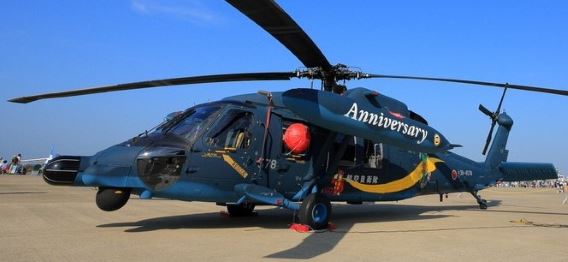 (Photo [Matsushima, August 2010]: Cp9asngf via Wikimedia Commons)
(Photo [Matsushima, August 2010]: Cp9asngf via Wikimedia Commons)
August 2020 Matsushima ARS 60th Anniversary U-125A 52-3002 (link) / UH-60J 08-4572 (link)
 (Photo: [Matsushima, Aug. 2020]: 鷲鷲(glass) via Twitter @s2000typerr2)
(Photo: [Matsushima, Aug. 2020]: 鷲鷲(glass) via Twitter @s2000typerr2)
For this occasion, variations of the designs used for the 50th anniversary were adopted. The fuselages of both aircraft had Matsushima indicated by a red star on a solid green map of Miyagi Prefecture alongside the words 60th (in red) ANNIVERSARY (in black [U-125A], yellow [UH-60J]). The U-125 carried Matsushima (in red) Air Rescue (in black) on its engine nacelles; the unit name had been applied in yellow to the UH-60J’S tanks.
 (Photo: [Matsushima, Aug. 2020]: 鷲鷲(glass) via Twitter @s2000typerr2)
(Photo: [Matsushima, Aug. 2020]: 鷲鷲(glass) via Twitter @s2000typerr2)
 (Photo: こつぽんvia Twitter @_kotupon_)
(Photo: こつぽんvia Twitter @_kotupon_)
The grey rectangular design (above) contained a white silhouette of each aircraft type and a Japanese sword, above which was a representation of the Shinto god of thunder (raijin) and the words 60th ANNIVERSARY SINCE 1960, below which was the god of wind (fūjin), as usually depicted wielding a bag of air, and the words MATSUSHIMA AIR RESCUE THAT OTHERS MAY LIVE. According to a Matsushima base tweet, the design’s concept denotes that the spirit of the JASDF rescue crews who bravely perform rescue operations in unforgiving environments is being handed down from generation to generation.
 A scene from the of necessity socially-distanced event that was held to mark the
A scene from the of necessity socially-distanced event that was held to mark the
Matsushima ARS’s 60th anniversary.
(Photo [Sept. 18, 2020] : AsagumoNews via Twitter @AsagumoNews52)
NAHA
(Formed as Provisional Naha Det. Oct. 30, 1972,
as ARS Oct. 16, 1973)
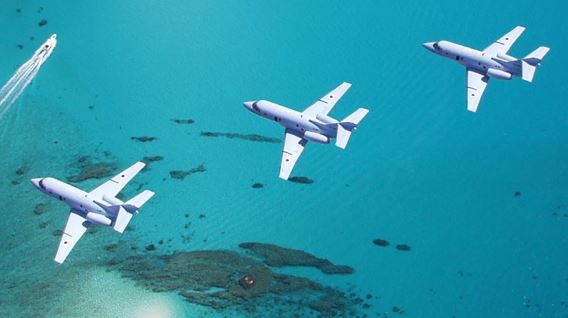 (Photo: Japan Ministry of Defense/JASDF)
(Photo: Japan Ministry of Defense/JASDF)
Following Okinawa’s reversion to Japanese sovereignty in 1972, no time was lost in establishing a Provisional Air Rescue Squadron, which came into being on October 30 that year. Reorganisation as the far-flung 10th full ARS reporting to the Air Rescue Wing was marked with a ceremony almost exactly a year later, on October 16, 1973. (This fine shot [link] of a Naha-based MU-2S was taken in that first year.)
Naha ARS Mission Episodes
| Date | Notes |
| Nov. 18, 1977 | Rescues 28 crew from South Korean cargo ship in difficulties 50 nautical miles (90km) off Okinawa |
| Jan. 16, 1983 | Airlifts suspected appendicitis case from trawler 280 nautical miles (520km) south of Okinawa |
| May 5, 1984 | Rescues eight from U.S.-registered, ocean-going yacht that had run aground at Cape Kyan, Okinawa Prefecture |
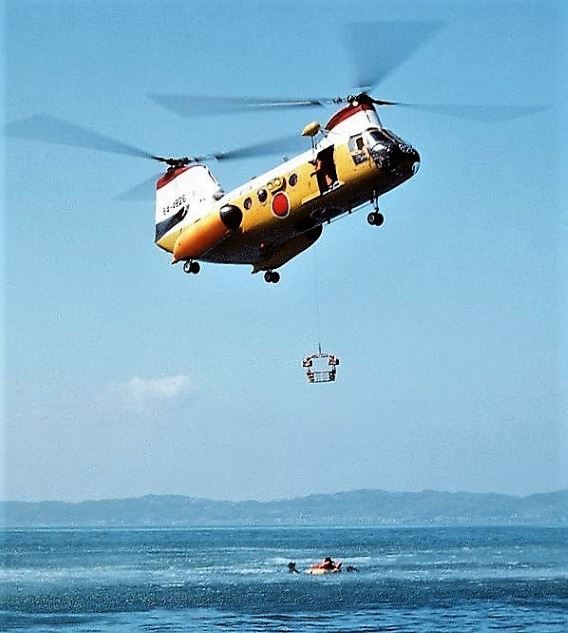 The crew of a Naha-based KV-107IIA-5 picks up a “survivor” during the Cope Angel search and
The crew of a Naha-based KV-107IIA-5 picks up a “survivor” during the Cope Angel search and
rescue exercise held in October 1980. The long-running biannual exercise involved U.S. elements
from Kadena AB, but the venue was switched for the first time to Misawa in 2017.
(Photo: Tech. Sgt. Michael E. Daniels/USAF via
National Archives and Records Administration [NARA])
The four decades-old scene above may have been repeated numerous times during Cope Angel exercises, but in recent years the Naha ARS has twice come to the rescue of U.S. Air Force F-15C pilots, on May 28, 2013, and June 11, 2018. On both occasions, they had been forced to eject over the ocean while serving with the resident 44th Fighter Squadron at Kadena.
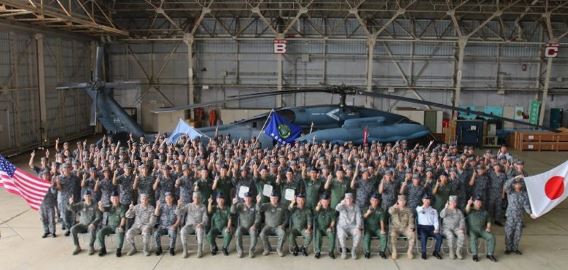 The Naha ARS turns out in force for the late June 2018 visit by U.S. Air Force Kadena AB personnel
The Naha ARS turns out in force for the late June 2018 visit by U.S. Air Force Kadena AB personnel
marking the successful rescue of the pilot who had ejected earlier that month. During an official
ceremony nine Naha ARS members received citations in grateful recognition of their efforts.
(Photo: JASDF Naha AB)
Details of other more typical operations can largely be gleaned from the record kept on the Air Rescue Wing’s website. These include regular hospitalization case airlift flights either from outlying islands in the Okinawa chain or from passing merchant ships. A selection of examples follows.
Dec. 15, 2015. A Naha ARS UH-60J answers an emergency call, relayed by the then JASDF Southwestern Composite Air Division HQ, from the Marshall Island-registered bulk carrier Luminous Nova, at the time under way around 450 nautical miles (830 km) to the southeast of the Okinawan capital. Suspected of having suffered a stroke, a 60-year-old Filipino crew member is airlifted to hospital.
Dec. 17, 2015. Two days later, a seriously ill Russian crew member from the Antarctic expedition icebreaker Akademik Shokalskiy is airlifted back a similar distance to hospital in Naha.
 (Photo: JASDF Air Rescue Wing)
(Photo: JASDF Air Rescue Wing)
April 18, 2016. (Above) At around 14:20 that afternoon, The Naha ARS obtains initial mission information from the Japan Coast Guard’s 11th Region, relayed via the JASDF Southwestern Composite Air Division HQ. Following receipt of an official Coast Gurad request for a flight to be despatched and the simultaneous order being given by the JASDF commander, a U-125A and UH-60J are launched at 16:10. They are sent to the aid of an injured Filipino crew member on board the Panama-registered liquefied natural gas tanker Pacific Notus. As the ship is then 300 nautical miles (560 km) off Ishigaki, the casualty is airlifted to a hospital on that island.
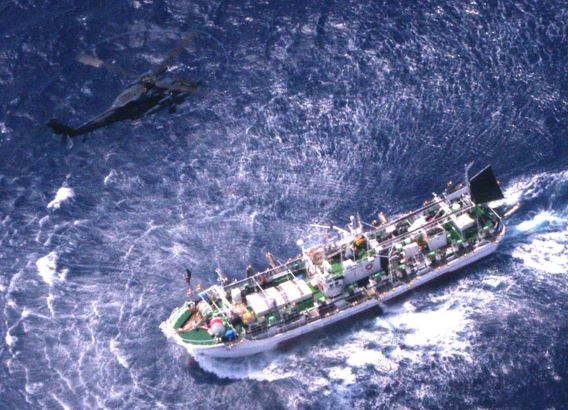 (Photo: JASDF Air Rescue Wing)
(Photo: JASDF Air Rescue Wing)
June 12, 2016. (Above) The usual two aircraft work in concert to bring an injured crew member from a squid fishing vessel from around 160 nautical miles (300 km) out at sea to hospital in Naha.
November 9, 2018. The line of communication from the Japan Coast Guard to the (since 2017) Southwestern Air Defense Force results in the crews of a U-125A and UH-60J being tasked with the rescue and airlift to Naha of four people adrift near the outlying island of Hate-jima.
 (Photo [taken at Naha AB]: JASDF Air Rescue Wing)
(Photo [taken at Naha AB]: JASDF Air Rescue Wing)
March 8, 2019. (Above) On this occasion it was the Okinawa prefectural governor who authorized the emergency airlift of a patient from Shin-Ishigaki airport to Naha for treatment.
In June 2019, the Air Rescue Wing website was carrying an interview with a Naha-based U-125A pilot, Capt. Tsubasa Hasegawa, himself aptly named as in written form his first name means ‘flight’, in spoken form ‘wings’.
 (Photo [Naha, October 2014]: Andy Binks)
(Photo [Naha, October 2014]: Andy Binks)
The U-125A’s role is to spearhead the rescue mission, proceeding quickly to the scene to confirm weather conditions and pinpoint the exact location of the person or persons in need of rescue. Having guided in the UH-60J, during the actual rescue the U-125A acts as a communications relay. The aircraft is also used to perform damage assessment reconnaissance flights in the event of a natural disaster.
There are three possible paths to becoming a U-125A pilot: aviation cadets, who can take an exam after graduating from high school; National Defense Academy flying personnel; or those who take the exam after graduating from a general university. Having been awarded their wings, those on the U-125A stream naturally have to take a rescue pilot course on the type with the Training Squadron at Komaki.
 Capt. Tsubasa Hasegawa (Photo: JASDF Air Rescue Wing)
Capt. Tsubasa Hasegawa (Photo: JASDF Air Rescue Wing)
In Hasegawa’s case, he had already developed a general interest in rescue operations at high school when TV news coverage featuring the Chitose ARS’s involvement in a major rescue mission (the South Korean freighter Marina Osaka tragedy of November 2004) pointed him in the direction of a specific career. Undergoing part of his training in the United States, he enjoys working in the low-altitude environment of an SAR pilot.
NAHA ARS SPECIAL MARKINGS
December 2002 Naha ARS 30th Anniversary KV-107IIA-5 04-4852 (link)
 (Photo: aya01@長野県特地派遣隊 via Twitter @aya01flt)
(Photo: aya01@長野県特地派遣隊 via Twitter @aya01flt)
The design featured the Naha ARS badge of a shisa—the traditional lion dog-like figure from Ryukyuan (Okinawan) mythology, itself derived from Chinese guardian lions—holding an injured young hawk. A variation on this theme was as expected used for the unit’s golden jubilee in 2022.
October 2012 Naha Airshow U-125A 32-3003 (link) / UH-60J 08-4590 (link)
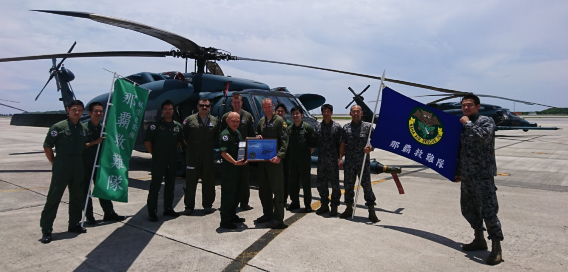 The U.S. Air Force pilot rescued in June 2018 receives a souvenir photo when visiting Naha AB to
The U.S. Air Force pilot rescued in June 2018 receives a souvenir photo when visiting Naha AB to
express his gratitude. The airmen on the right are holding aloft the Naha ARS flag of a shisa, the
mythological figure incorporated into the design of the 30th anniversary KV-107IIA-5 in 2002.
(Photo: U.S. Forces Japan/Kadena AB)
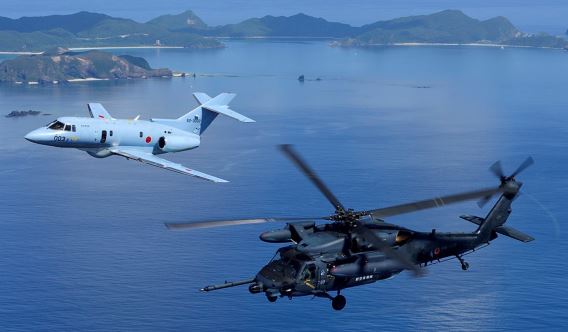 The photo that was presented to the U.S. Air Force pilot shows two of the aircraft assigned to
The photo that was presented to the U.S. Air Force pilot shows two of the aircraft assigned to
Naha ARS in 2014, as evidenced by the dark blue 60th anniversary badges.
(Photo: JASDF Air Rescue Wing)
December 2022 Naha 50th Anniversary U-125A 52-3023 / UH-60J 98-4609
 For more photos, see the December 2022 Bulletin Board report.
For more photos, see the December 2022 Bulletin Board report.
 (Photos: ニッパー via Twitter @4TIYuySHA957Rh4)
(Photos: ニッパー via Twitter @4TIYuySHA957Rh4)
Five decades having passed since Okinawa reverted to Japanese sovereignty, and 1972 also being the year in which the JASDF commenced air-rescue operations from Naha, it was only right and proper for the ARS to mark the dual occasion in its own way.
 Surprisingly not carried on the aircraft, the unit’s anniversary badge did echo elements from
Surprisingly not carried on the aircraft, the unit’s anniversary badge did echo elements from
the design adopted for them. (Image: JASDF Naha AB via Twitter @Naha_AirBase)
 (Photo: トラベラー@12月11日沖縄 via Twitter @komatsu_JASDF)
(Photo: トラベラー@12月11日沖縄 via Twitter @komatsu_JASDF)
 (Photo: はみんぐばーど via Twitter @FTB2007)
(Photo: はみんぐばーど via Twitter @FTB2007)
As they are usually seen in pairs, forward-facing winged versions of the dog-lion shisa were carried on the fuselage sides of both the U-125A and UH-60J. Importantly, these were of the open-mouthed shisa variety, said to ward off evil spirits; closed mouths are to keep in good spirits. Next to the anniversary titling below each shisa was a scarlet bloom of the Okinawa prefectural flower, the deigo (Indian coral tree).
Both aircraft carried the rectangular minsa patterns found in traditional Ryukyu Island textiles. The U-125A had these on its engines and at the top its tailfin, the UH-60J on its cabin doors, fuel tanks and on the upper surfaces of its horizontal tail. The vertical tails of both aircrfat featured four hibiscus flowers in aquatic images in the style of bingata, the again locally developed dyeing technique for which stencils are aptly used.
 The tails of both aircraft were given sprinklings of aquatic and floral designs,
The tails of both aircraft were given sprinklings of aquatic and floral designs,
including two more deigo blooms.
 (Photos: [Top] KKK via Twitter @kkk125tw; [above] JUBi via Twitter @okiteaqua)
(Photos: [Top] KKK via Twitter @kkk125tw; [above] JUBi via Twitter @okiteaqua)
NIIGATA
(Base Squadron formed under Air Rescue Group Dec. 16, 1966;
ARS formed Dec. 15, 1967)
 The Niigata ARS has operated the UH-60J since the arrival of the first example
The Niigata ARS has operated the UH-60J since the arrival of the first example
of the type on February 16, 2007. (Photo: JASDF)
Coincidentally, while writing this section in Saitama Prefecture at 22:22 on the evening of June 18, 2019, gentle tremors were felt. These were very quickly reported to have been caused by a major earthquake off the coast of Yamagata Prefecture, which mainly affected the castle city of Murakami, population 60,000, in northern Niigata Prefecture.
The first SDF element to arrive at the scene was a pair of 6th Air Wing F-15Js that took off from Komatsu on a reconnaissance mission at 22:39. Part of the mobilization of a steady stream of aviation assets from all three SDFs that formed an initial response, a Niigata-based U-125A and UH-60J were the last to be deployed, taking off at 23:25 and 23:34, respectively. The Niigata Sub-Base itself naturally served as a hub during the operation. On this occasion, thankfully only 26 people were injured, and there were no fatalities.
Niigata is, however, somewhat prone to earthquakes. That in June 1964 triggered a tsunami that killed 28 and devastated the city’s port area. In more recent times, the Chuetsu Earthquake in October 2004 and the Chuetsu Offshore Earthquake in July 2007 claimed 68 and 15 lives, respectively.
 Hooked up as safety demands to a static grounding point, a Niigata ARS U-125A sits on the tarmac
Hooked up as safety demands to a static grounding point, a Niigata ARS U-125A sits on the tarmac
at its home base. The unit took delivery of its first U-125A on June 28, 2006. (Photo: JASDF)
The JASDF presence at Niigata dates back to the formation, on March 1, 1958, of a detachment under the then Provisional Central Command Centre reporting to Air Group Command HQ. The Niigata Detachment was transferred to the 4th Air Wing on July 15, 1961, but soon changed hands and came under Central Air Region command as the Niigata Base Squadron on March 15, 1962. This came under the Air Rescue Group umbrella on December 15, 1966, and became the Niigata ARS on October 25, 1967.
Niigata ARS Mission Episodes
| Date | Notes |
| July 30, 1969 | Rescues three from five crew on two Niigata University yachts that capsized off Hiyoriyama in city of Niigata |
| Nov. 30, 1971 | Night rescue of all 48 crew members from Liberian- registered tanker Juliana that had run aground in strong winds and broken into two, also at Hiyoriyama |
| Sept. 27–29, 1975 | Works with prefectural rescue team on ground to locate and rescue two climbers in the Asahi mountain range on Niigata-Yamagata border |
| Nov. 3, 1981 | Rescues 12 from the Dragon III, a Panama-registered cargo ship, off Sado Island |
| Apr. 3, 1984 | Airlifts supplies to village of Iwafune-asahi that was cut off by heavy snow |
A low point in the unit’s more recent history came on the afternoon of April 14, 2005, when all four crew members were killed in an MU-2A that crashed on the northwest slopes of Mt. Mikagura during a search and rescue (SAR) training flight. Attempts to contact the aircraft continued 30 minutes after the last communication, and so it was more than hour before a search was initiated. Having first spotted a wingtip fuel tank, it was a Niigata UH-60J crew that discovered the wreckage and had the sombre task of enabling the official formalities to be carried out back at base.
The wreckage was retrieved from the site on June 4 and transported to Komaki. The aircraft had amassed 6,280 flying hours in the 18 years since its delivery as the last of its type in January 1987 and had 1,330 airframe hours remaining.
The findings of the accident investigation, released on October 7 that year, cited excessive bank angle as having contributed to the aircraft stalling at a height that did not permit recovery. To prevent any recurrence, the investigation recommended thorough reviews of crew coordination procedures and elements of SAR flight operations combined with re-training on the MU-2A’s low-speed flight characteristics and on the misperceptions that can arise in flight.
The paramedic/rescuer on board the ill-fated MU-2A, Master Sgt. Kazuhiko Takayama, had been heavily involved in operations at the time of the Chuetsu Earthquake the previous year. He was the father of actor Yūko Takayama, who went on to play the role of a UH-60J pilot in the 2008 film Rescue Wings. She was reportedly spotted by an entertainment industry talent scout when visiting Tokyo to attend a memorial service for her father in 2005.
 A Niigata-based UH-60J hovers off the port beam of a trawler off the city of Niigata in
A Niigata-based UH-60J hovers off the port beam of a trawler off the city of Niigata in
December 2016. The unit was responding to a request for assistance from the
Japan Coast Guard in airlifting one of the ship’s crew members to hospital.
(Photo: JASDF Air Rescue Wing)
When circumstances demand, the Niigata ARS is naturally called upon to assist in the responses to disasters beyond its prefectural borders, such as following the earthquake that struck Nagano Prefecture in May 2018.
Its recent operations with sister units include the fatal accident involving the Cessna in June 2017 and the search for a glider that ended happily in May 2019 (see Komatsu ARS). (See Akita ARS for a combined operation conducted in February 2013.)
 A Niigata ARS UH-60J helicopter during helipad landing and takeoff practice conducted atop a
A Niigata ARS UH-60J helicopter during helipad landing and takeoff practice conducted atop a
newly-built general hospital in the city of Murakami, 50km north along the coast from Niigata.
(Photo [posted Dec. 2020]: JASDF Niigata Sub-Base via Twitter @jasdf_niigata)
NIIGATA ARS SPECIAL MARKINGS
 Seen here on the side of a building at Niigata Sub-Base, the unit’s badge features Niigata
Seen here on the side of a building at Niigata Sub-Base, the unit’s badge features Niigata
Prefecture’s official bird and plant, the toki (crested ibis) and tsubaki (Japanese camellia).
(Photo [June 2012]: Cp9asngf via Wikimedia Commons)
1997 Niigata ARS 35th Anniversary KV-107IIA-5 94-4850 (link)
An otherwise standard-finish KV-107IIA-5, this aircraft featured the ARS’s pink crested ibis and camellia badge (seen above) over its tail serial number. A large red ‘3’ and (on the forward door) green ‘5’, over which ‘NIIGATA’ was superimposed in blue, completed the scheme
August 2002 Niigata Sub-Base 40th Anniversary MU-2A 23-3226 / KV-107IIA-5 64-4839 (link)
As seen below, the MU-2A featured an overall yellow scheme with a red, white and blue cheat line extending along the fuselage and up the tail, which featured a large white-outlined red ‘40’. On this occasion, the crested ibis featured prominently on the blue and white fuselage sides of the KV-107IIA-5. The bird also featured in the 40th anniversary design on the side of the front rotor mast.
 (Photos above and below [taken Aug. 25, 2002]: BANCHOU via Twitter @BANF30)
(Photos above and below [taken Aug. 25, 2002]: BANCHOU via Twitter @BANF30)

October 2004 JASDF 50th Anniversary MU-2A 23-3226 (link)
This was one of the five aircraft given a common colour scheme (see Hamamatsu ARS). The eight-man paintshop team that carried out a painstaking job, which included putting the aircraft on jacks to paint the undersides, was led by a Capt. Tomoharu Kitagawa.
 The Niigata ARS having worked on the specially finished MU-2A, its KV-107IIA-5 was just given a
The Niigata ARS having worked on the specially finished MU-2A, its KV-107IIA-5 was just given a
50th anniversary sticker. (Photo: aya01@長野県特地派遣隊 via Twitter @aya01flt)
June-October 2008 Air Rescue Wing 50th Anniversary KV-107IIA-5 04-4852 (link) (link)
The Niigata ARS’s contribution to celebrations that took place in the Air Rescue Wing’s Golden Jubilee year was the challenging task of applying the common scheme to a KV-107IIA-5, one of the six aircraft thus finished. In Niigata’s case, the scheme also celebrated the sub-base’s 46th anniversary.
 Marking the dual celebration, ’852 carried this design from around May 2008 to
Marking the dual celebration, ’852 carried this design from around May 2008 to
at least March 2009. (Photos via X [formerly Twitter]: [Top, Hamamatsu, Mar. 2009]: 雄の子♂あーちゃん @magus490);
(Photos via X [formerly Twitter]: [Top, Hamamatsu, Mar. 2009]: 雄の子♂あーちゃん @magus490);
[above, Niigata, June 2008] aya01@長野県特地派遣隊 @aya01flt)
June 2012 Niigata Sub-Base 50th Anniversary U-125A 22-3019 / UH-60J 68-4564
Although the wrong colour in the case of the U-125A, the feather incorporated into the design (link), which on the left side also resembles the shape of Niigata Prefecture, might have been intended as a reference to the designated prefectural bird, the crested ibis. Alternatively, the feather might be a throw back to the dove wing used in the original design carried on rescue T-34As and T-6Gs. Note that the U-125A carried the message ‘Anniversary from 1962’ on its engines.
 (Above and below) 50th Anniversary JASDF Niigata Sub-Base UH-60J 68-4564
(Above and below) 50th Anniversary JASDF Niigata Sub-Base UH-60J 68-4564
(Photos [Niigata, June 2012]: Cp9asngf via Wikimedia Commons)

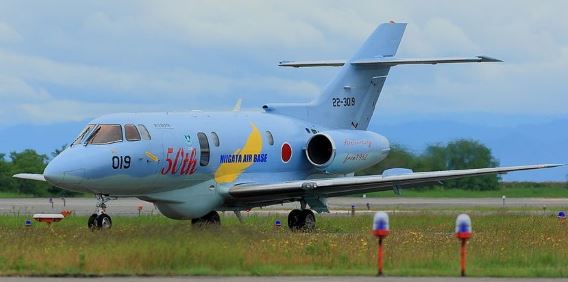 (Photo [Niigata, May 2012]: Cp9asngf via Wikimedia Commons)
(Photo [Niigata, May 2012]: Cp9asngf via Wikimedia Commons)
November 2017 Niigata Sub-Base 55th Anniversary U-125A 92-3010 / UH-60J 98-4589
 (Photos: ドリ秋@少尉帯は泥沼 via Twitter @doriaki25699)
(Photos: ドリ秋@少尉帯は泥沼 via Twitter @doriaki25699)

October 2022 Niigata Sub-Base 60th Anniversary U-125A 52-3003 / UH-60J 98-4589
 In keeping with tradition, two aircraft were given makeovers that incorporated a crested ibis
In keeping with tradition, two aircraft were given makeovers that incorporated a crested ibis
design in time for an anniversary open house event, held on October 9, 2022, which was by
lottery and limited to 1,000 visitors. Close-ups of the markings on the
opposite sides to those shown are provided below.
 (Photos: [Top] スタンレー via Twitter @Stanley_sanmy; [above] YAS-3 via Twitter @bbseki)
(Photos: [Top] スタンレー via Twitter @Stanley_sanmy; [above] YAS-3 via Twitter @bbseki)
 (Photos above and below: スタンレー via Twitter @Stanley_sanmy)
(Photos above and below: スタンレー via Twitter @Stanley_sanmy)

 (Photos above and below: ありす via Twitter @justynasty5220)
(Photos above and below: ありす via Twitter @justynasty5220)

 (Photo: JASDF Niigata Sub-Base via Twitter @jasdf_niigata)
(Photo: JASDF Niigata Sub-Base via Twitter @jasdf_niigata)
 (Photo: JASDF)
(Photo: JASDF)
NYUTABARU
(Detachment formed Mar. 1, 1960,
redesignated ARS Dec. 1, 1964)
 (Photo [Nyutabaru, October 2014]: Andy Binks)
(Photo [Nyutabaru, October 2014]: Andy Binks)
The third air rescue detachment formed at Nyutabaru on March 1, 1960, around two years after the wartime Army airfield base was established as a JASDF facility. The unit was re-designated as an ARS on December 1, 1964.
Initial equipment was the T-34A and H-19B, to which were added the T-6G and S-62J in 1964. The S-62J’s tenure was short-lived, as KV-107IIs began to arrive on the scene in December 1968.
In an early operation, conducted from July 5 to July 13, 1961, the unit was involved in the search for the four pilots from a pair of likewise Nyutabaru-based 17th Flying Training Wing T-33As that had collided 17 nautical miles (32km) off Aburatsu, Miyazaki Prefecture. Two pilots were successfully rescued, but one was killed and the other reported missing.
On December 13, 1966, the Nyutabaru ARS was scrambled after a collision between two 6th Sqn F-86Fs over the then Minami-Amabe coastal district (now the city of Saiki) of Oita Prefecture. Happily, on this occasion the ARS rescued one pilot, and the other was picked up by a passing fishing vessel.
Deliveries to Nyutabaru of the far more capable MU-2S commenced in December 1969, the end of the year in which both of the earlier fixed-wing types bowed out, but tragedy struck twice in the type’s career there.
On September 2, 1970, less than a year after the type’s introduction, an aircraft crashed near Hikone, Shiga Prefecture, when on route to Komatsu on a training flight. All four crew members lost their lives. Then, on April 11, 1973, another training flight claimed the lives of four more crew members, when their aircraft crashed near Yatogi waterfall up in the mountain town of Tsuno, Miyazaki Prefecture, soon after takeoff from Nyutabaru.
Nyutabaru ARS Mission Episodes
| Date | Notes |
| Dec. 23, 1972 | Rescues all nine crew from tanker that had run aground due to radar failure in bad weather en route to Kagoshima |
| May 31, 1976 | Rescues pilot of 202nd Sqn F-104J who had ejected around 90 nautical miles (165km) east of Nyutabaru |
In the meantime, in the evening of August 8, 1972, a Nyutabaru ARS KV-107II-5 had crashed into the sea in flames around 40 nautical miles (80 km) from base when searching for a U.S. Navy E-2 Hawkeye in conjunction with a Nyutabaru MU-2S. When reported in the November 1972 issue of Aireview, two of the eight men on board the aircraft commanded by a 1st Lt. Toda were confirmed to have lost their lives, two had survived, and the four others were posted as missing.
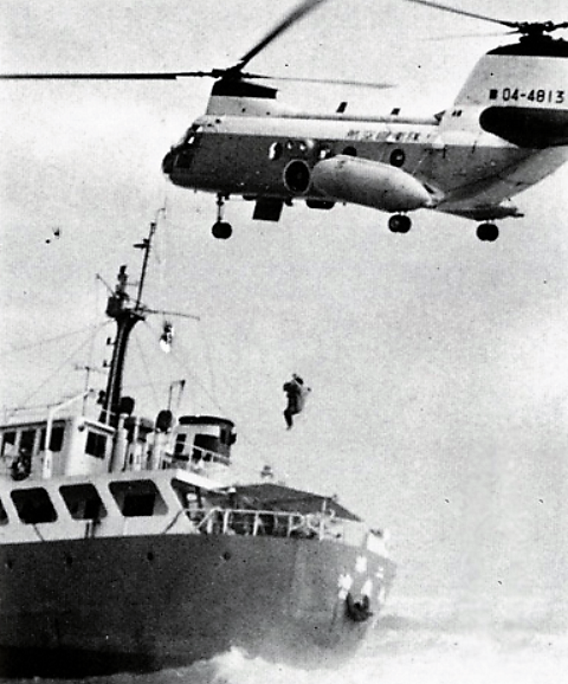 In December 1972, a Nyutabaru ARS KV-107II crew successfully rescued nine crew members from
In December 1972, a Nyutabaru ARS KV-107II crew successfully rescued nine crew members from
a tanker that had run aground at Shintomi, the nearby town formed by merging the
original villages of Nyuta and Tonda. (Photo: JASDF Nyutabaru AB)
NYUTABARU ARS PHOTO CHRONOLOGY
 The scene at Nyutabaru in December 1968 following the arrival of the resident ARS’s first
The scene at Nyutabaru in December 1968 following the arrival of the resident ARS’s first
KV-107II-5. The last flight of a Nyutabaru-based KV-107II was to take place
30 years later, in March 1999. (Photo: JASDF Nyutabaru AB)
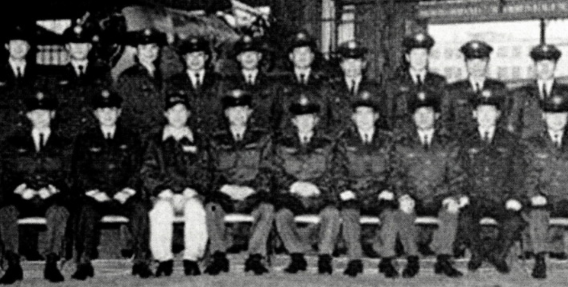 Three months after the first KV-107II-5’s arrival, March 1969, witnessed the
Three months after the first KV-107II-5’s arrival, March 1969, witnessed the
final SAR mission flown by a T-6G. (Photo: JASDF Nyutabaru AB)
 The crew of the first MU-2S stands to attention on the flight line after bringing in the first MU-2S
The crew of the first MU-2S stands to attention on the flight line after bringing in the first MU-2S
assigned to Nyutabaru in December 1969. The last flight of a Nyutabaru-based MU-2A, the later
version with uprated engines, took place in September 2000. (Photo: JASDF Nyutabaru AB)
 (Photo [Nyutabaru, Nov. 1995]: Takao Kadokami)
(Photo [Nyutabaru, Nov. 1995]: Takao Kadokami)
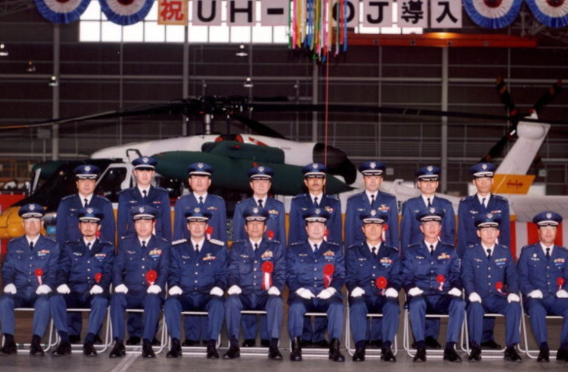 Nyutabaru, March 1997. The arrival of the first UH-60J is celebrated in
Nyutabaru, March 1997. The arrival of the first UH-60J is celebrated in
the time-honoured fashion. (Photo: JASDF Nyutabaru AB)
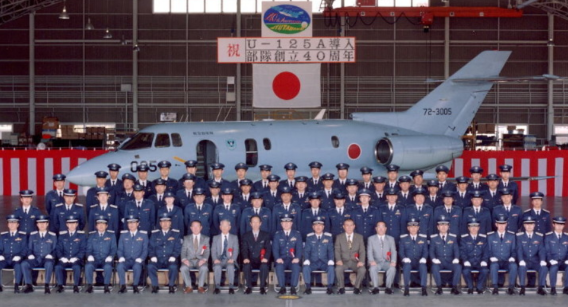 Another group photo, this time taken in March 2000, commemorates the unit’s 40th anniversary,
Another group photo, this time taken in March 2000, commemorates the unit’s 40th anniversary,
which happily coincided with the entry into service of its first U-125A.
(Photo: JASDF Nyutabaru AB)
 Squadron members congregate in front of the Nyutabaru ARS MU-2S that has just completed the
Squadron members congregate in front of the Nyutabaru ARS MU-2S that has just completed the
unit’s last flight of the type. The banner carries an expression of thanks to the aircraft for all
the hardships endured during its service career. (Photo [Sept. 2000]: JASDF Nyutabaru AB)
A ceremony to mark the unit’s Golden Jubilee was held on March 1, 2010.
The Akagi company visit to Nyutabaru in April 2016 coincided with the second day of flight training for a pilot who was taking the difficult route of converting from the F-4EJ Phantom to the UH-60J. The instructor pilot was 1st Lt. Kurosaki, who had previously taken the T-7 and T-400 courses before moving to the UH-60J. He and a flight engineer joined the trainee pilot for the pre-flight checks, which with questions and explanations along the way can take two or three times longer than the usual 10 minutes.
Not surprisingly, the flight training course commences with the basic familiarization with the controls and hovering. When deemed sufficiently proficient, the pilot’s flight training is conducted away from the base in the vicinity of the small nearby town of Takanabe.
 (Photo [Nyutabaru, Dec. 2012]: Takao Kadokami)
(Photo [Nyutabaru, Dec. 2012]: Takao Kadokami)
 The crew of a Nyutabaru ARS UH-60J is put through its paces at the coordinated disaster training
The crew of a Nyutabaru ARS UH-60J is put through its paces at the coordinated disaster training
exercise held in Miyazaki City in mid-October 2016. A total of around 4,500 people from 123
prefectural, municipal and local-level organizations and groups took part in an exercise
that simulated the response to a major earthquake and tsunami.
(Photo: たばる (Tabaru) via Twitter @taba_san)
Recent Operations
In the early hours of December 6, 2018, Nyutabaru U-125A and UH-60J crews worked in conjunction with their ARS counterparts at Ashiya and Hamamatsu as well as with the Japan Coast Guard and U.S. and Australian units in a protracted and extensive search operation. Five crew members of a U.S. Marine Corps KC-130J were declared missing after a nighttime midair collision with an F/A-18 Hornet south of Cape Muroto, Kochi Prefecture; only one of the latter’s two-man crew survived. The search was finally called off early on December 11.
A Nyutabaru U-125A was launched around an hour and 15 minutes after an earthquake struck Kumamoto Prefecture on the evening of January 3, 2019, the first JASDF assets over the town of Nagomi having been a pair of Tsuiki-based F-2As that had taken off just 15 minutes before.
Late at night on May 18, 2019, authorization was received from the governor of Kagoshima Prefecture for a UH-60J to join in the rescue of more than 300 hikers and others left stranded by torrential rainfall on Yakushima, a small island around 30 nautical miles (60 km) southwest of Cape Sata, Kyushu’s southernmost point. The aircraft returned from the mission on May 20.
 (Photo [Nyutabaru, October 2014]: Andy Binks)
(Photo [Nyutabaru, October 2014]: Andy Binks)
NYUTABARU ARS SPECIAL MARKINGS
February 2010 Nyutabaru ARS 50th Anniversary U-125A 42-3022 (link)
February 2020 Nyutabaru ARS 60th Anniversary U-125A 52-3003, UH-60J 08-4571
 (Photo via Twitter @Marudayoooo)
(Photo via Twitter @Marudayoooo)
The fuselage of the U-125A was adorned with a large ‘60’, the ‘0’ of which enclosed a silhouette in the shape of Miyazaki Prefecture, with a small TH and ANNIVERSARY to the side and below, respectively; U-125A appeared above the logo. Its engines carried the multicoloured words NYUTAAirRescue and other, smaller bright elements were added in keeping with Miyazaki’s fame as one of the sunniest parts of Japan. The pink flowers are probably a reference to the moss phlox found in a garden open to the public in the nearby town of Shintomi. The UH-60J featured the same logo, wording and design elements, only in different colours.
 (Photo via Twitter @Marudayoooo)
(Photo via Twitter @Marudayoooo)
AIR RESCUE TRAINING SQUADRON
(Formed at Hamamatsu Oct. 1, 1958;
reformed at Komaki Mar. 1, 1971)
The newly formed Kyūnan Kyōikutai (Air Rescue Training Squadron) joined the then Hamamatsu air rescue squadron on October 1, 1958.
Alongside the Komaki air rescue detachment, the Training Squadron participated in the organization’s first major disaster response missions following the Ise Bay typhoon (Typhoon Vera), which struck on September 26, 1959.
In 1961, torrential rain and the resultant flooding and landslides around the city of Iida, Nagano Prefecture, resulted in the Training Squadron’s involvement from June 30 to July 9.
After relocation from Hamamatsu, operations were recommenced from Komaki (see above), which has remained the ARW’s dedicated training base, on March 1, 1971.
AIR RESCUE WING MARKINGS
 (Photo [Hyakuri, Oct. 1972]: Akira Watanabe)
(Photo [Hyakuri, Oct. 1972]: Akira Watanabe)
At some stage in its formative years, the then Air Rescue Group adopted a tail marking comprising a stylized form of the kanji 救 (kyū, meaning rescue) and the wing of a dove (above). Only carried on the T-6Gs and T-34As, the marking disappeared with the gradual demise of those types.
 (Komaki, February 2014)
(Komaki, February 2014)
ARW aircraft now carry a design devised by a Staff Sgt Jisuke Fujikawa from the Training Squadron and adopted in September 1988. A blue shield incorporates the silhouette of an eagle with another shield on its breast containing a clasped hand design, representing protection and rescue. A scroll bears the words `Air Rescue Wing`, and a panel beneath carries the name, in English, of the aircraft’s home base or, in the case of Komaki-based aircraft, TRAINING SQ, as shown above.
The Ikaros publication, JSDF Squadron, which appeared in the summer of 1996, contains a photo of the first U-125A with the words Air Rescue in cursive script on the side of its port engine.
AIR RESCUE WING SPECIAL MARKINGS
2008 ARW 50th Anniversary
For the 50th anniversary, one of each type of aircraft in service (but two U-125As) was painted in the same specially designed blue eagle colour scheme: Akita and Matsushima (U-125A); Chitose (UH-60J), Hamamatsu (MU-2A), and Niigata (KV-107IIA-5). These aircraft are listed under their respective ARSs but can be seen here: MU-2A (link), U-125As (link) (link), KV-107IIA-5 (link) and UH-60J (link). A Misawa-based Helicopter Airlift Squadron CH-47J was also included (link).
A 50th anniversary emblem was also designed, as seen on this Training Squadron U-125A in October 2008 (link).
2018 ARW 60th Anniversary
 (Photo: JASDF Air Rescue Wing)
(Photo: JASDF Air Rescue Wing)
Unlike the flamboyant days of the 50th anniversary, none of the unit’s aircraft received a special colour scheme in honour of the occasion; two Komatsu ARS U-125As continue to sport low-viz camouflage. The only identifying mark this time was a subdued, specially designed logo (below), partly in JASDF navy blue (popularly known as ‘samurai blue’), applied in sticker form to the aircraft.
 The design is made up of an ARW eagle, representing strength and reassurance, centrally positioned
The design is made up of an ARW eagle, representing strength and reassurance, centrally positioned
against a background of six magatama (comma-shaped beads, one for every 10 years of the ARW’s
existence). In ancient Japan, these decorations were regarded as possessing a strong force; here
they symbolize the spirit to confront challenges without giving in to anything. (Image: JASDF)
 (Photo: マイティ[Mighty] via Twitter @mighty0715)
(Photo: マイティ[Mighty] via Twitter @mighty0715)
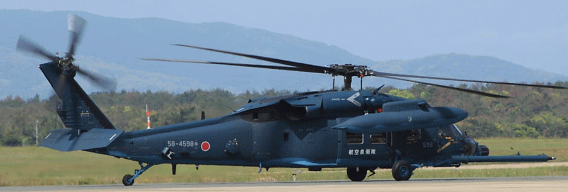 (Photo: JASDF Air Rescue Wing)
(Photo: JASDF Air Rescue Wing)
|
Air Transport |
Formed | circa 1970 (Air Transport Wing, Miho, C-46) |
| Disbanded | March 1978 (upon formation of Tactical Air Group organization) |
Also referred to as the Flying Training Squadron (a direct translation of its name in Japanese, Hikōkyōikutai), this unit flew C-46s and then YS-11s from Miho under the direct command of the Air Transport Wing. Following the introduction of the TAG system, the training role remained at Miho but was passed to the 403rd Sqn.
ATTS Tail Marking
From 1975–78, ATTS YS-11s featured a disc-shaped tail marking of a red cherry blossom, which appeared in blue on 401st Squadron YS-11s from 1972–78.
|
Air Transport Wing |
Formed | Oct. 31, 1958 (Kisarazu, C-46) |
| Renamed | 1st Air Transport Group (March 31, 1978) |
 An Air Transport Wing C-46D at Tsuiki in December 1962. (Photo: Takao Kadokami)
An Air Transport Wing C-46D at Tsuiki in December 1962. (Photo: Takao Kadokami)
The Tachikawa Air Transport Group (q.v.) had been in operation only a matter of months when relocated to Miho as the Provisional Miho Air Transport Group (q.v.) in June 1955. Miho having formed the transport operations hub, the Air Transport Wing became the Air Transport Group, which controlled the 401st Squadron at Miho and the 402nd at Kisarazu, in 1978.
 On static display at Iwakuni in May 1966, this Air Transport Wing C-46D carried the Pegasus
On static display at Iwakuni in May 1966, this Air Transport Wing C-46D carried the Pegasus
marking shown below aft of the passenger windows. (Photos: Takao Kadokami)

|
Electronic Intelligence Sqn |
Formed | Nov. 1991 (Iruma, Air Defence Command HQ, YS-11EL) |
| Current Base | Iruma (Electronic Tactics Group, RC-2 and YS-11EB) |
Its name literally and euphemistically meaning Electronic Flight Measurement Unit, this squadron is tasked with signal interception (SI), in other words the monitoring of the electro-magnetic wave environment and signals gathering in and around Japan. This has naturally included the conducting of flights to the disputed Senkaku Islands in the East China Sea and, on occasion, the monitoring of missiles launched by North Korea.
Initiated in the early 1980s, initial JASDF research had revolved around the Toshiba-developed J/ALR-1 signals intelligence gathering system with a view to its installation in a C-130H. When the costs of this project proved prohibitive, this system was installed on the EC-1 operated by the Electronic Warfare Support Squadron (now ECM Training Sqn, see above).
 (Photo [Iruma, November 2014]: Andy Binks)
(Photo [Iruma, November 2014]: Andy Binks)
The formation of this squadron in November 1991 consolidated the JASDF operations of its fleet of four YS-11EBs in a separate unit. Its initial equipment was the two standard YS-11Cs that had been modified to YS-11EL (for ELINT) standard and previously operated by the ECM Training Squadron. The first aircraft (12-1161) was fitted with the J/ALR-1 intelligence gathering system in September 1982. Having completed a test programme at the then Air Proving Wing (now Air Development and Test Wing), the aircraft was delivered to the ECM Training Squadron in 1983. The next aircraft (92-1157) was modified to YS-11EL standard in April 1991, but the final two (82-1155 and 02-1159), completed in 1995 and 1996, were to the new YS-11EB standard that incorporated the powerplant and other changes of the ECM Training Squadron’s YS-11EAs along with the installation of the J/ALR-2 system. The first two YS-11ELs were retrospectively brought up to YS-11EB standard in 1997 (’161) and 1998 (’157), respectively. Not surprisingly, these aircraft are finished in an overall grey colour scheme devoid of squadron markings.
 (Photo [Iruma, November 2014]: Andy Binks)
(Photo [Iruma, November 2014]: Andy Binks)
A major step towards the retirement of the YS-11EBs was taken on October 1, 2020, when the second prototype C-2, converted for the ELINT role in 2018, was officially handed over to the unit as the RC-2 to commence crew training (see Bulletin Board). The aircraft is seen here (link) in its anonymous squadron guise at Iruma on October 14, 2020.
|
Electronic Warfare Sqn |
Formed | As ECM Training Flight: July 1963 (EC-46D) As Electronic Warfare Support Sqn: Mar. 22, 1964 (Air Defense Command HQ Sqn, Kisarazu, EC-46D) As ECM Training Sqn: July 1, 1993 to Aug. 1, 2014 |
| Current Base | Iruma (Air Tactics Development Wing, EC-1 and YS-11EA) |
In June 1959, a radar evaluation unit was formed at Iruma in June 1959 with the primary task of checking the functions of airfield radars and radar sites. In July 1963, an office was set up within that unit to complete preparations for the independent air operations of what was called the Electronic Countermeasures (ECM) Training Flight, which although based at Kisarazu was likewise to report direct to the Iruma-based Air Defense Command HQ Squadron. Its initial equipment was two C-46D transports converted to EC-46D standard.
Elevated in status in March 1964, the newly designated Electronic Warfare Support Squadron and the radar evaluation unit relocated to Iruma on May 31, 1968. A third EC-46D was received on November 30, 1970, and a T-33A (unofficially designated an ET-33A) equipped with a pod-mounted AN/ALQ-172 electronic countermeasures system on December 16, 1971. The tasks now were research into ECM and the improvement of JASDF ECM capabilities.
Offering enhanced jamming capabilities over the EC-46D, the first specially modified YS-11C (12-1163) made its maiden flight as a YS-11E from Japan Aircraft Manufacturing (NIPPI)’s Atsugi facility on February 9, 1976. The aircraft was received into service on February 3, 1977, and followed by another (12-1162) in February 1979. Their replacement complete, the last of the ageing EC-46Ds was withdrawn from use on March 11, 1978.
 (Photo [Iruma, November 2014]: Andy Binks)
(Photo [Iruma, November 2014]: Andy Binks)
Naturally drawing its personnel initially from transport units, pilots with a wealth of fighter experience began to join the squadron’s ranks from the 1980s.
The squadron’s capabilities were further enhanced by the arrival of a C-1 modified to EC-1 standard in 1986 and a YS-11E upgrade programme initiated in 1991. This involved replacing the original Rolls-Royce Dart engines and four-blade Dowty propellers with more powerful Allison-IHI T64s driving three-blade Hamilton Standard propellers and the installation of J/ALQ-7 equipment. Another obvious external difference was the replacement of the many YS-11Es many radome lumps and bumps with blade aerials. The first of the pair of what were initially known as YS-11EKai (later YS-11EA, 12-1163) made its first post-modification flight on September 12, 1991, and, following extensive testing at the Air Development and Test Wing, was finally delivered in July 1993. On the first of that month, what had been the Electronic Warfare Support Squadron had, in a throwback to its early days as the ECM Training Flight, changed its name to the ECM Training Squadron.
Having also operated the first YS-11EL modified for the electronic intelligence (ELINT)-gathering role since 1983, this was passed with the then only recently (April 1991) modified second aircraft to the Electronic Intelligence Squadron (see above) as its initial equipment upon its formation in November 1991.
On August 1, 2014, the unit and the Iruma-based Electronic Tactics Group to which it reports were moved under the command of the Air Tactics Development Wing at Yokota. This apparently prompted the name change to Electronic Warfare Squadron.
 (Photo [Iruma, November 2014]: Andy Binks)
(Photo [Iruma, November 2014]: Andy Binks)
ECM Training Sqn / Electronic Warfare Squadron Markings
Adopted in 1973, the then Electronic Warfare Support Squadron’s official emblem, which consisted of a helmeted crow with three lightning flashes emanating from its claws, was designed by its then commanding officer, a Lt. Col. Nozaki.
The YS-11EAs, however, for many years carried the same tricolour fin marking (link) as the aircraft flown by the Central Air Defense Command HQ Support Squadron (the former Air Defense Command HQ, see below). They lost their colourful scheme and markings in 2008 (’162) and late in 2010 (’163 [link]).
In November 2023, the Electronic Warfare Squadron took the surprise step of applying a unit badge to the tails of YS-11EA 163 and of its EC-1 (link), which had previously been devoid of markings. (See Bulletin Board story.)
|
Flight Check Group |
Formed | Oct. 1, 1958 (Air Traffic Control Group HQ, Miho, C-46) |
| Current Base | Iruma (Air Support Command, U-125, U-680A) |
Having commenced operations with a C-46 from Miho in October 1958 and moved to Kisarazu on June 1, 1959, this navaids calibration unit has operated entirely out of Iruma since May 31, 1968; Iruma had been home to its 2nd Detachment since December 26, 1963.
 A Flight Check Group C-46D at Yokota AB in June 1974. Delivered to the JASDF in January 1955,
A Flight Check Group C-46D at Yokota AB in June 1974. Delivered to the JASDF in January 1955,
this aircraft was withdrawn from use in October 1976 and sold to a U.S. company in 1977.
(Photo: TROUT via Twitter @TROUT92241176)
 (Photo [Ashiya, Oct. 1979]: Takao Kadokami)
(Photo [Ashiya, Oct. 1979]: Takao Kadokami)
To commence the replacement if the C-46, the first YS-11FC was delivered on February 25, 1971, and followed by the first MU-2J in 1975; the last C-46 finally bowed out on March 11, 1978.
In 1984, in addition to one YS-11FC and four MU-2Js, the unit was operating a number of T-33As.
 (Photo [Nyutabaru, May 1986]: Takao Kadokami)
(Photo [Nyutabaru, May 1986]: Takao Kadokami)
[ADDITIONAL TEXT PENDING]
Flight Check Group Markings
Although originally designed as a black-and-white checkerboard tail marking in 1960, higher visibility red and white was eventually adopted. In the shape of a shield, the squadron badge depicts pieces on a chess board with a lightning flash.
 Kissing (distant) cousins. In March 2020, another stage in the Flight Check Group’s re-equipment
Kissing (distant) cousins. In March 2020, another stage in the Flight Check Group’s re-equipment
programme, and a step closer to the last YS-11FC’s retirement, was completed following the
arrival of the first two of three U-680As. (Photo: JASDF/Iruma AB via Twitter)
 Iruma, May 15, 2020 (Photo: JASDF/Iruma AB via Twitter @jasdf_iruma)
Iruma, May 15, 2020 (Photo: JASDF/Iruma AB via Twitter @jasdf_iruma)
 (Photo: Japan Ministry of Defense/JASDF)
(Photo: Japan Ministry of Defense/JASDF)
FLIGHT CHECK GROUP SPECIAL MARKINGS
In 2008, YS-11FC 52-1151 (link) carried a badge (link) on its fuselage commemorating the unit’s 50th anniversary.
2004 JASDF 60th Anniversary U-125 49-3043
 (Photo [Nyutabaru, Dec. 2004]: Takao Kadokami)
(Photo [Nyutabaru, Dec. 2004]: Takao Kadokami)
|
Flying Training School |
Formed | July 6, 1954 (Hamamatsu, T-34A) |
| Reorganized | As 1st Flying Training School, Nov. 1, 1955 (Hamamatsu, with Branch School at Hofu) |
|
Helicopter Airlift |
Formed | As Iruma Provisional Helicopter Airlift Sqn: Oct. 1, 1987 As Iruma Helicopter Airlift Sqn: Oct. 1, 1988 (under Air Rescue Wing, CH-47J) |
| Current Bases | Iruma, Kasuga, Misawa, Naha (under Air Rescue Wing, HQ Iruma, CH-47J) |
To meet a pressing requirement for helicopters capable of, for example, airlifting materiel and personnel from air bases to remote radar sites on resupply missions, the procurement of Chinook helicopters was commenced in 1984, and the first example received for testing by the then Air Proving Wing (now Air Development and Test Wing) in December 1986.
The first Helicopter Airlift Squadron was declared fully operational on October 1, 1988, exactly a year after its formation as the Iruma Provisional Helicopter Airlift Sqn; this squadron also fulfills the training role. The second squadron formed at Misawa on March 31, 1989, with those at Naha and Kasuga following in March and May 1993, respectively. (See table below.)
Two weeks prior to the formation of the second squadron at Misawa in March 1989, a JASDF reorganization resulted in the Air Rescue Wing being moved under the command of Air Support Command on March 16, 1989.
| Formation Dates of Helicopter Airlift Squadrons | |||
| Base | Date Formed | Base | Date Formed |
| Iruma | Provisional: Oct. 1, 1987 Oct. 1, 1988 |
Naha | Mar. 31, 1992 |
| Misawa | Mar. 31, 1989 | Kasuga | May 22, 1992 |
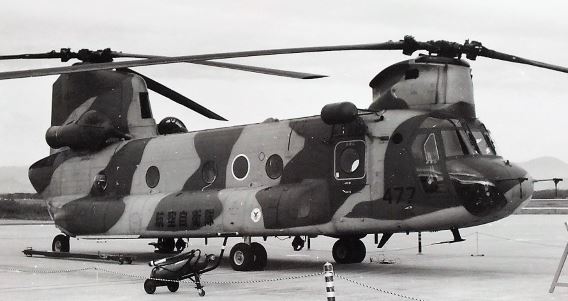 (Photo [Tsuiki, Nov. 1995]: Takao Kadokami)
(Photo [Tsuiki, Nov. 1995]: Takao Kadokami)
The Helicopter Airlift Squadron organization has provided invaluable support during natural disasters. Examples of its operations in the first 10 years of its existence are shown below.
| Helicopter Airlift Squadron Operations | ||
| Year | Mission/Event | Squadron(s) |
| 1994 | Reconnaissance of earthquake-affected areas | Misawa |
| 1995 | Disaster relief in aftermath of the Great Hanshin Earthquake | (All) |
| 1996 | Emergency airlift | Misawa |
| Airlift of wreckage from crashed passenger aircraft | Kasuga | |
| 1997 | (Twice) Airlift of personnel to assist cleanup operations following oil tanker capsize | (All) |
| 1998 | Forest firefighting | Iruma |
Following another reorganization, after 25 years the Air Rescue Wing moved from being under Air Support Command to Air Defence Command control on March 26, 2013.
 October 13, 2019. An Iruma Helicopter Airlift Squadron crew during rescue operations in the city
October 13, 2019. An Iruma Helicopter Airlift Squadron crew during rescue operations in the city
of Tatebayashi, Gunma Prefecture, in the aftermath of Typhoon No. 19. (Photo: JASDF Iruma AB)
 A photo of a Misawa-based CH-47J posted to mark the 49th anniversary of the first flight of the
A photo of a Misawa-based CH-47J posted to mark the 49th anniversary of the first flight of the
YHC-1B, the prototype of the helicopter that was to become the Chinook.
(Photo [posted Sept. 19, 2020]: JASDF Misawa via Twitter @jasdf_misawa)
Helicopter Airlift Sqn Markings
As they now come under the control of the Air Rescue Wing HQ at Iruma, the aircraft currently carry the same marking as the JASDF’s Air Rescue Wing on their rear rotor masts.
Helicopter Airlift Sqn Special Markings
JASDF 50th Anniversary 2004 27-4481 (Iruma) (link) (link)
Air Rescue Wing 50th Anniversary 2008 47-4485 (Iruma) (link) (link)
JASDF 60th Anniversary 2014 e.g. 27-4487 (link), 67-4496 and 37-4501 (Iruma)
Selected aircraft carried only an anniversary marking on either side of their forward rotor masts.
 (Photo [Iruma, Nov. 2014]: Andy Binks)
(Photo [Iruma, Nov. 2014]: Andy Binks)
Air Rescue Wing 60th Anniversary 2018 e.g. 27-4487 (Misawa [link]), 77-4497 (Iruma [link])
Once again, selected aircraft carried only an anniversary marking on either side of their forward rotor masts.
|
Iwo To Drone |
Formed | As Provisional Drone Operation Unit (under Iwo To Base Sqn): Mar. 31, 1992 As Iwo To Drone Operation Flight (under Iwo To Base Detachment): Mar. 31, 1994 (UF-104J/JA) |
| Disbanded | Iwo To, Mar. 31, 1997 |
Having established a presence alongside the JMSDF facilities on the island in January 1984, the JASDF formed the Provisional Drone Operation Unit under the Iwo To Base Squadron in March 1992. The squadron was re-designated as a detachment the following month, and the provisional unit officially renamed the Iwo To Drone Operation Flight in March 1994.
The aircraft most closely associated with the JASDF operation on Iwo To were the 12 F-104J Starfighters converted to UF-104JA (and two interim-standard UF-104J) target drones. The last Starfighters in JASDF service, the first was shot down in March 1995, the last two years later, after which the flight was disbanded. If there were ever plans to resurrect the unit to operate other candidates for conversion, such as the Mitsubishi F-1, they never reached fruition.
Two excellent videos on YouTube show the two UF-104Js during testing. The first covers a manned test flight [link], the second a remote flight from a ground station with a manned chase aircraft [link]. These clearly show the unit’s scorpion tail marking.
|
Kisarazu Squadron/ |
Formed | As Kisarazu Training Sqn: Oct. 17, 1958 (Air Transport Wing, C-46) As Kisarazu Detachment: Dec. 1, 1958 (Air Transport Wing, C-46) As Kisarazu Sqn: June 1, 1959 (Air Transport Wing, C-46) |
| Reorganized | As Iruma Sqn: June 1, 1968 (Air Transport Wing, C-46) then 402nd Sqn (q.v.): Oct. 1, 1968 (2nd TAG, C-46) |
|
Provisional Matsushima |
Formed | As NSF Provisional Matsushima Detachment: June 1, 1954 As JASDF Provisional Matsushima Detachment: July 1, 1954 |
| Reorganized | As 2nd Flying School, Nov. 1, 1955 |
|
Miho Detachment |
Formed | As Provisional Miho Detachment: June 6, 1955 (Miho, C-46) |
| Renamed | Air Transport Wing (Oct. 1, 1958) |
Originally formed as the Tachikawa Air Transport Group (q.v.) in 1955, the short-lived Miho Detachment formed following the move from Tachikawa to Miho in Tottori Prefecture as a provisional unit on June 6 that year. It was from this that the two-squadron Air Transport Wing was formed in 1958.
REGIONAL AIR DEFENSE FORCE HQ
SUPPORT FLIGHT GROUPS
What were originally formed as regional air command support flights were all re-designated as regional air defense HQ support flight groups in August 2014.
|
Northern |
Formed | As Northern Air Detachment: July 1960 (Misawa, T-33A) As Northern Air Command Support Flight: TBC As Northern Air Defense Force HQ Support Flight Group: Aug. 1, 2014 |
| Current Base | Misawa (T-4) |
Initially formed under Air Defense HQ command in July 1960, what was originally the Northern Air Detachment reported to the commanding officer of the Northern Air Command from the following year. Its sole aircraft, a T-33A, was maintained by the 81st Air Group then based at Misawa.
Northern Air Defense Force HQ Support Flight Group Tail Marking
Initially, aircraft assigned to the then Northern Air Detachment carried two red stripes like those of the 81st Air Group. From 1980 to around the mid-1990s, the marking combined Aomori Prefecture and the apples for which it is famous in Japan.
Formerly worn by the 8th Sqn in the F-86F and F-1 eras, the unit’s current blue tail marking is of a stylized ‘3’ (denoting the 3rd Air Wing) beneath the outline of the Shimokita Peninsula, in Aomori Prefecture. The marking was first worn on the unit’s T-33As from 1978, during its time as the Northern Air Command Support Flight.
 A lineup of five T-33As from second-line units at Tsuiki on the Culture Day national holiday,
A lineup of five T-33As from second-line units at Tsuiki on the Culture Day national holiday,
November 3, 1979. Nearest the camera is an aircraft sporting the blue tail marking of the
3rd Air Wing’s Northern Support Squadron, next come three training aircraft from the
1st Air Wing’s 33rd Squadron and, bringing up the rear, a lone aircraft from the
Air Defense Command’s HQ Squadron. (Photo: Takao Kadokami)
|
Central |
Formed | As Provisional Air Training Flight: August 1956 (Johnson [Iruma] AB, T-33A) As Air Defense Command HQ Squadron: Sept. 1, 1958 (Johnson [Iruma] AB, T-33A) As Central Air Defense Force HQ Support Flight Group: Aug. 1, 2014 |
| Current Base | Iruma (T-4, U-4) |
The formation of the then Air Defense Command HQ Squadron, with two T-33As on September 1, 1958, came a month after the August 1958 establishment of the JASDF Central Air Defense Force HQ and Iruma AB at Johnson AB*.
Forming the HQ Squadron was essentially an exercise in renaming its forerunner, the Provisional Air Training Flight (Rinji Kōkū Kunrentai) that had formed in August 1956, flown the two T-33As and boasted all of 15 personnel. Aside from the flying unit, a total of seven elements, including electronic warfare and radar evaluation units as well as maintenance and airfield operation squadrons, were to gradually come under the HQ Squadron umbrella over the next few years.
In terms of aircraft, the HQ Squadron went on to receive T-6Gs in 1960, two of which were flying alongside five F-86Fs** and six T-33As by 1961. The T-6Gs were replaced by five T-34As on March 25, 1964. Then as now, the unit’s aircraft were used for liaison flights and check rides as well as training for pilots assigned to ground duties.
In March 1964, an ECM Training Flight was formed at Kisarazu but came under HQ Squadron command. (The development of this unit was covered earlier, under the Electronic Warfare Support Sqn.). That year, the unit’s inventory comprised six F-86Fs and 12 T-33As.
On April 1, 1977, the unit received four RF-86Fs with sufficient flying hours remaining on their airframes following the end of the type’s operations with the 501st Sqn. These remained in service until October 1979.
In 1980, it was the turn of the T-34As to be replaced, in this case by five B-65 Queen Airs transferred from the JMSDF on March 4. Two were destined to be passed on to the Southwestern HQ Flight later that same year.
 Here in its standard scheme, B-65 03-3093 lands at Iruma in 1997, the year before the arrival of the
Here in its standard scheme, B-65 03-3093 lands at Iruma in 1997, the year before the arrival of the
first U-4 heralded a colourful retirement scheme. (Photo: BANCHOUさん via Twitter @BANF30)
At its peak, the unit was flying 12 F-86Fs. On March 15, 1982, it fell to the pilot of aircraft ’497 to bring the curtain down on the era of JASDF F-86F operations. Unfortunately, bad weather forced the cancellation of the pre-ceremony farewell flight, and so in something of an anti-climax all present had to be content with seeing the aircraft being taxied along the runway one last time.
In 1984, the unit was equipped with around 20 T-33As and the three B-65s and overseeing the operations of the three ECM Sqn YS-11Es.
 (Photo [Tsuki, 1989]: Takao Kadokami)
(Photo [Tsuki, 1989]: Takao Kadokami)
The unit has been operating the T-4 and U-4 since December 1994 and February 1998 respectively; the last B-65 was retired on February 10, 1998.
It was on August 1, 2014, that the support squadron under the command of Air Defense Command HQ was transferred to the Central Air Defense Force as its HQ Support Flight Group.
 Having led the so-called Silver Impulse display at the 2022 Iruma air show, Central Air Defense
Having led the so-called Silver Impulse display at the 2022 Iruma air show, Central Air Defense
Force HQ Support FG CO Lt. Col. Nobuyuki Watanabe sits front and centre at the photo call
following his last flight. Having amassed 5,000 flying hours in a career that had spanned 35
years, Watanabe (55) was a little over the 51 average age of the four display pilots that day.
(Photo: JASDF Iruma AB via Twitter @jasdf_iruma)
* The joint use of Johnson itself, which was to be redesignated Johnson Air Station on December 30, 1960, was agreed in June 1961, but the U.S. military ceased using the base for air operations a year later. After a protracted general winding down of the U.S. Air Force presence, the base was finally fully returned to the Japanese government in September 1978.
** Although one Japanese source states that five F-86Fs were on strength at the time of squadron’s formation, these were received in 1960.
Central Air Defense Force HQ Support Flight Group Tail Marking
The unit’s red, yellow and blue chevron tail marking, denoting the then three principal (northern, central and western) air commands, was first adopted in 1962, in the early days of its time as the Air Defense Command HQ Squadron. The shape is said to be a stylized ヒ (hi), the other reading of the kanji 飛 (fly).
 (Photo [Tsuiki, November 1991]: Takao Kadokami)
(Photo [Tsuiki, November 1991]: Takao Kadokami)
Air Defense Command HQ Squadron Special Markings
JASDF 40th Anniversary 1994 B-65 03-3093
The aircraft sported a large marking on both sides of its fuselage (link) (link) and 40Th [sic] Anniversary on its engine nacelles. Showing the aircraft in flight, this photo shows the extent of the stripe markings on the undersides (link).
B-65 03-3093 Last Flight, Feb. 3, 1998
 03-3093 still carries vestiges of the markings applied when flown for the last time on February 3,
03-3093 still carries vestiges of the markings applied when flown for the last time on February 3,
1998, and for its last public appearance, at the Iruma air show the following November.
(Photo [Old Car Center KUDAN, Naraha, Dec. 2019]: Warren Hardcastle)
The aircraft’s message to its pilots and ground crews—40th Anniversary, Thank you for your tenderness—was carried on both sides of the cabin, and for the ceremony the aircraft itself adorned with a ribbon with Congratulation B-65 03-3093 Complete Mission 8600hour (link).
Iruma Air Show, November 1998 T-33As incl. 51-5668 (the last delivered to the JASDF [below]); “Rainbow Monster” B-65 03-3093
 (Photo [Nyutabaru, November 1998]: Takao Kadokami)
(Photo [Nyutabaru, November 1998]: Takao Kadokami)
Primarily for the Iruma air show held in November 1998, the then Air Defense Command HQ Squadron’s T-33As were adorned with a flamboyant, aerobatic team-like scheme better seen in colour photos taken at the event (link) (link). The aircraft carried the words Shining Shooting Star II in red aft of the nose serial number (link) and individual formation numbers on their engine intakes as well as variously coloured fuselage stripes. As seen in this lineup at Iruma in July 2000 (link), the final year of the T-33A’s service life, these had been removed.
Despite its flying days being over, 093’s PR value was once again utilized at that year’s Iruma air show in the form of a lavish colour scheme (link). Details of the left-side door can be seen here (link) and those on the left engine nacelle [B-65・093・1969–1998] here (link). Although at this stage possibly not genuine, the names of two women, without ranks, were given as the ground crew members beneath the windscreen on the left side (link).
|
Western |
Formed | As Western HQ Support Flight: 1972 As Western Air Defense Force HQ Support Flight Group: Aug. 1, 2014 |
| Current Base | Kasuga (T-4) |
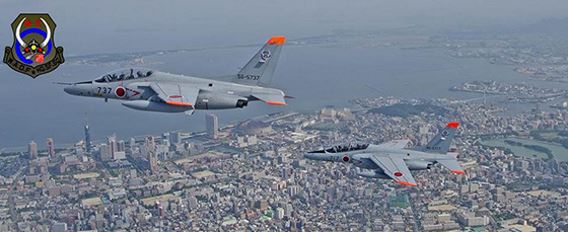 (Photo: JASDF Kasuga)
(Photo: JASDF Kasuga)
[TEXT IN PREPARATION]
 On aircraft visiting Tsuiki, November 2017
On aircraft visiting Tsuiki, November 2017
(Photo: Hunini via Wikimedia Commons)
Western Air Defense Force HQ Support Flight Group Tail Marking
The tail marking depicts a samurai helmet. In earlier times, Western HQ Support Flight T-33As (below) had worn a green tail marking of the same design as that of the 8th Air Wing at Tsuiki.
 (Photo [Iwakuni, May 1994]: Takao Kadokami)
(Photo [Iwakuni, May 1994]: Takao Kadokami)
The same aircraft can be seen in colour at Iruma two months later, in July 1994 (link).
|
Southwestern |
Formed |
As Southwestern HQ Support Flight: May 1972 (Naha) As Southwestern Air Defense Force HQ |
| Current Base | Naha (T-4) |
 December 2008. Specially marked for the traditional end-of-year airshow, a T-4 assigned to the
December 2008. Specially marked for the traditional end-of-year airshow, a T-4 assigned to the
Southwestern Support Flight of the then Southwestern Composite Air Division (since July 2017,
the Southwestern Air Defense Force) sits on the apron at Naha.
Like its counterpart in the western region, when initially formed in May 1972, after Okinawa had reverted to Japanese administration, the Southwestern HQ Support Flight operated a Southwestern Composite Air Division aircraft on loan from its active unit, the 83rd Air Group, as required.
Two former JMSDF B-65 Queen Airs, which had briefly seen service with the then Air Defense Command HQ Squadron, were passed on to the Southwestern HQ Support Flight late in 1980. The last surviving example was withdrawn from use with the Southwestern Support Flight on March 1, 1999.
Southwestern Air Defense Force HQ Support Flight Group Tail Marking
The unit’s T-4s sport a yellow tail marking of a shisa, a lion-like Ryukyuan god said to protect Okinawa from evil. This was first adopted on the then Southwestern Support Flight’s aircraft in December 1984.
 (Photo [Tsuiki, November 1986]: Takao Kadokami)
(Photo [Tsuiki, November 1986]: Takao Kadokami)
 (Photo [Naha, May 1990]: Takao Kadokami)
(Photo [Naha, May 1990]: Takao Kadokami)
From 1981, both the flight’s B-65s and T-33As had carried the Southern Cross marking of the resident Starfighter squadron, the 207th (q.v.).
|
Tachikawa Air Transport |
Formed | As Provisional Tachikawa Detachment: Feb. 1, 1955 (Tachikawa, C-46) As Tachikawa Air Transport Group: Mar. 1, 1955 (C-46) |
| Renamed | Provisional Miho Air Group (June 6, 1955) |
The origins of today’s 1st Tactical Airlift Group, the Tachikawa Air Transport Group itself started off as a provisional detachment in February 1955 but moved to Miho on June 6 that very same year. Basic transport pilot course T-1, which had commenced in March 1955 and comprised four experienced pilots, was outsourced and conducted at Tachikawa by U.S. Air Force instructors.
Glossary of Principal Terms Used in JASDF Squadron Histories
| Airborne Warning & Surveillance Group (Misawa) |
Hikō Keikai Kanshigun | 飛行警戒監視群 |
| Airborne Warning & Control Group (Hamamatsu) (to Mar. 26, 2020) |
Keikaikōkūtai | 警戒航空隊 |
| Airborne Warning & Control Wing (Hamamatsu) (from Mar. 26, 2020) |
Keikaikōkūdan | 警戒航空団 |
| Air Development & Test Command (Mar. 1989–) |
Kōkū Kaihatsu Jikken Shūdan |
航空開発実験集団 |
| Air Development & Test Wing (Mar. 1989–) |
Hikō Kaihatsu Jikkendan |
飛行開発実験団 |
| Airlift Squadron | (Used only in English references to transport squadrons) |
|
| Air Proving Group (Dec. 1955 to Apr. 1974) |
Jikken Kōkūtai | 実験航空隊 |
| Air Proving Wing (Apr. 1974 to Mar. 1989) |
Kōkū Jikkendan | 航空実験団 |
| Air Rescue Detachment | Kyūnan Bunkentai (Feb. 1959 to Nov. 1964) |
救難分遣隊 |
| Kyūnantai (Dec. 1964–) |
救難隊 | |
| Air Rescue Group (1961 to 1971) |
Kōkū Kyūnangun | 航空救難群 |
| Air Rescue Squadron (1958 to 1961) |
Kyūnan Kōkūtai | 救難航空隊 |
| Air Rescue Training Squadron | Kyūnan Kyōikutai | 救難教育隊 |
| Air Rescue Wing (Mar. 1971–) |
Kōkū Kyūnandan | 航空救難団 |
| Air Support Command | Kōkū Shien Shūdan | 航空支援集団 |
| Air Tactics Development Wing (Yokota) |
Kōkūsengi Kyōdōdan | 航空戦術教導団 |
| Air Training Command | Kōkū Kyōiku Shūdan | 航空教育集団 |
| Air Transport Group (1955–58) | Yusōkōkūtai | 輸送航空隊 |
| Air Transport Wing (1958–78) | Yusōkōkūdan | 輸送航空団 |
| Air Wing | Kōkūdan | 航空団 |
| Branch School (1950s) | Bunkō | 分校 |
| Central Air Command HQ Support Squadron |
Chūbu Kōkūhōmentai Shireibu Shien Hikōtai |
中部航空方面隊 司令部支援飛行隊 |
| Detachment | Hakentai | 派遣隊 |
| ECM Training Flight (1963–64) | Denshi Kunrentai | 電子訓練隊 |
| ECM Training Squadron (1993–2014) | ||
| Electronic Intelligence (ELINT) Squadron | Denshi Hikōsokuteitai | 電子飛行測定隊 |
| Electronic Tactics Group | Denshi Sakusengun | 電子作戦群 |
| Electronic Warfare Squadron (2014-) | Denshisentai | 電子戦隊 |
| Electronic Warfare Support Squadron (1964–1993) |
Denshisenshientai | 電子戦支援隊 |
| Fighter Training Group | Hikō Kyōiku Kōkūtai | 飛行教育航空隊 |
| Fighter Training Squadron | (Used only in English references to 23rd Sqn) |
|
| Flight Check Group | Hikōtenkentai | 飛行点検隊 |
| Flying Training School (1956–59) | Sōjūgakkōbunkō | 操縦学校分校 |
| Flying Training Squadron | Hikōkyōikutai | 飛行教育隊 |
| Flying Training Wing | Hikōkyōikudan | 飛行教育団 |
| Helicopter Airlift Squadron | Herikoputa-kūyutai | ヘリコプター 空輸隊 |
| Northern Air Command Support Flight |
Hokubu Kōkūhōmentai Shienhikōhan |
北部航空方面隊 支援飛行班 |
| Southwestern Support Flight Group |
Nansei Shienhikōhan | 南西支援飛行班 |
| Special Airlift Group | Tokubetsu Kōkūyusōtai | 特別航空輸送隊 |
| Tactical Airlift Group* | Yusōkōkūtai | 輸送航空隊 |
| Tactical Fighter Training Group** |
Hikōkyōdōgun | 飛行教導群 |
| Technical School | Gijutsu Gakkō | 術科学校 |
| Western Air Defense Force HQ Support Flight Squadron |
Seibu Kōkūhōmentai Shireibu Shienhikōtai |
西部航空方面隊 司令部支援飛行隊 |
| * 3rd TAG calls itself the 3rd Tactical Airlift Wing ** Aggressor Squadron, known in Japanese as Hikōkyōdōtai 1981–2014 |
||
Please note that the current total of five pages devoted to JASDF
squadron histories are constantly being updated and improved.
(All photographs on this website are copyright J-HangarSpace
unless otherwise stated.)
|
JSDF Squadron, series published in Kōkū Fan magazine, Bunrindo (various issues 1997–2001) Japan Self-Defense Force Squadron, Ikaros, Summer 1996 JASDF F-15 All-Unit Guide, JWings, October 2014 issue Mitsubishi T-2/F-1 Shashinshū (Photo Collection), Hobby Japan, 2017 Mitsubishi T-2, Famous Airplanes of the World No. 116, Bunrindo, 2006 Watanabe, Akira, Japanese Air Arms, 1952–1984, (self-published in English), 1984 Japanese Wikipedia JASDF base/unit websites
|


